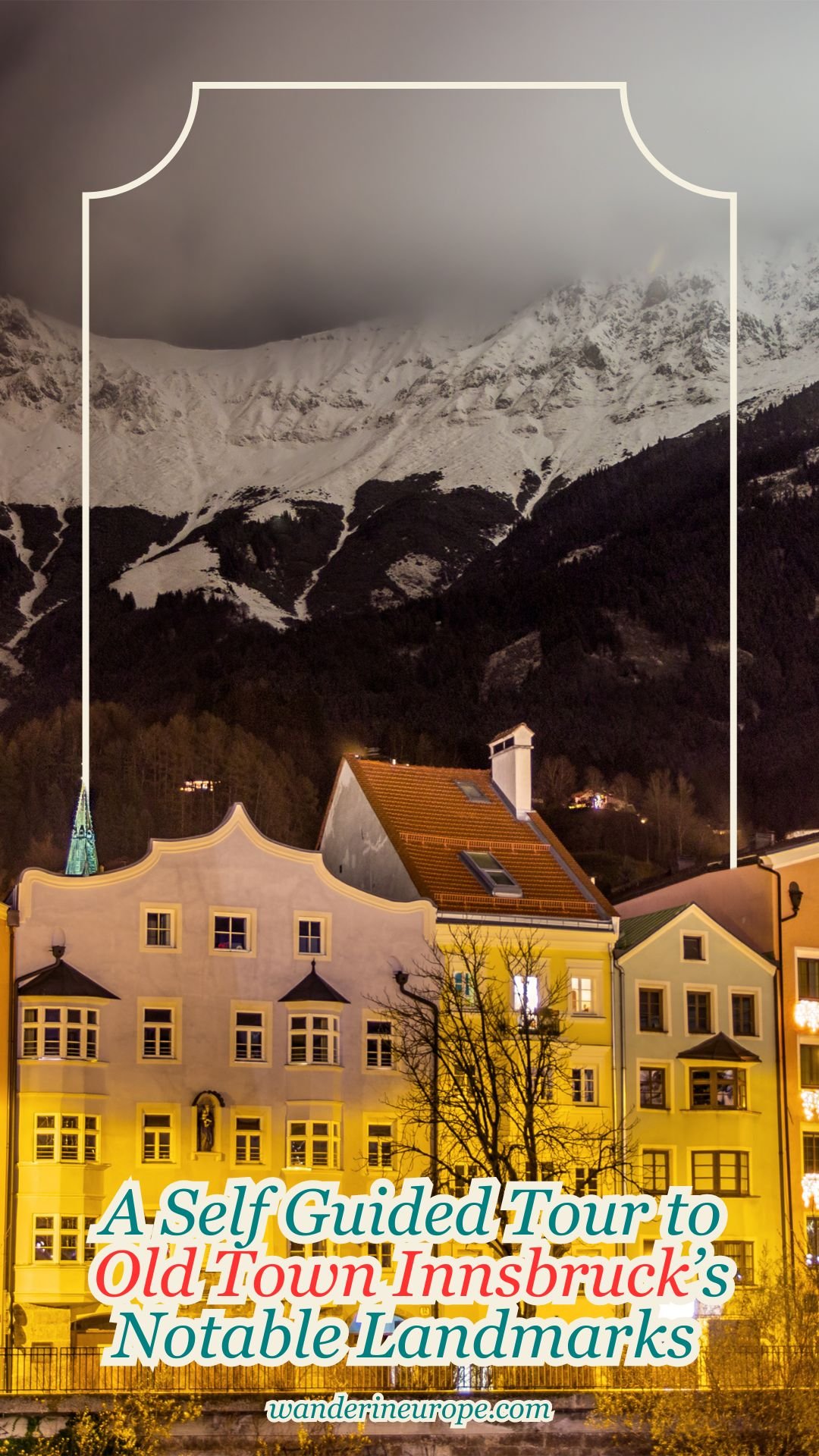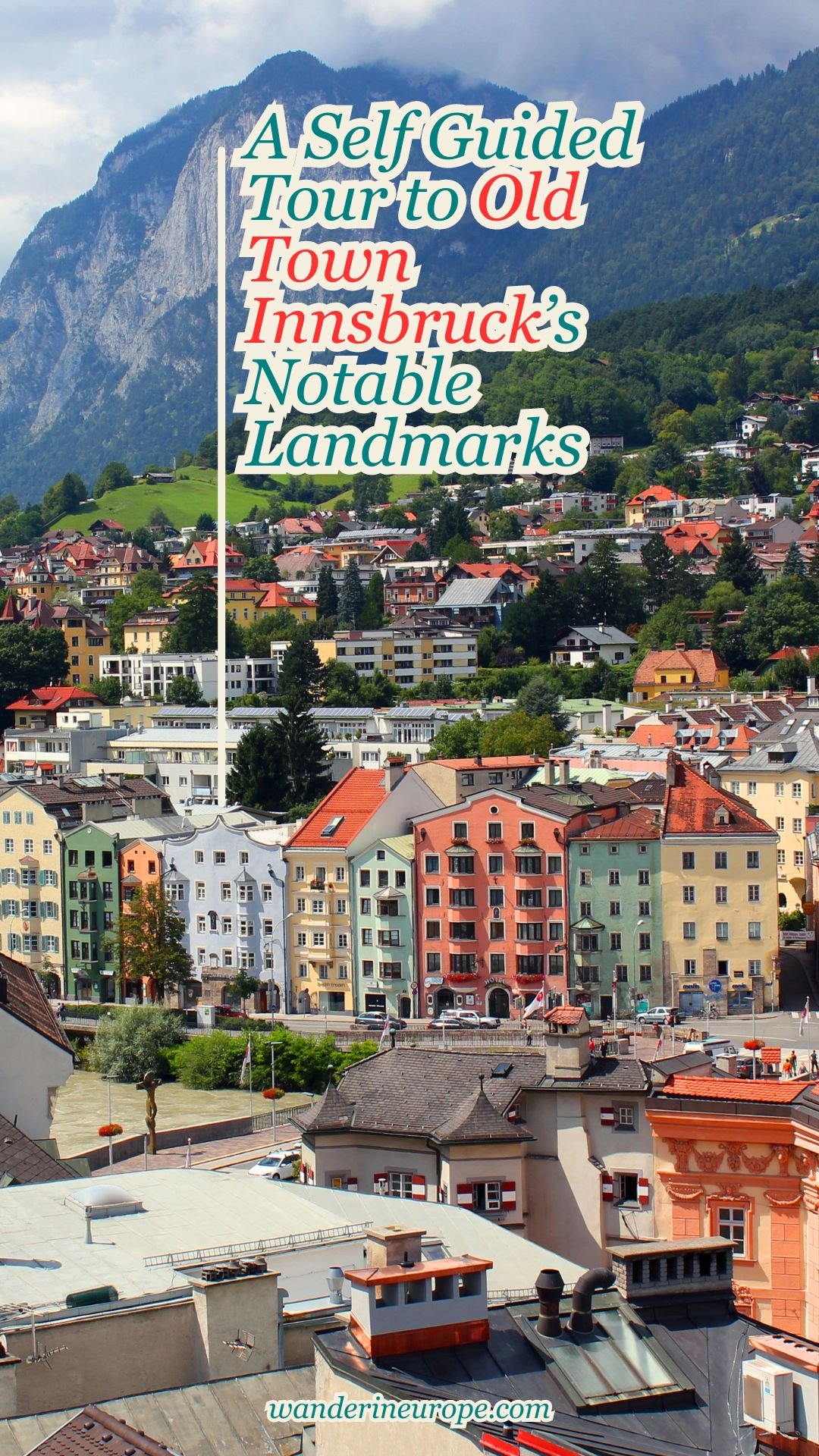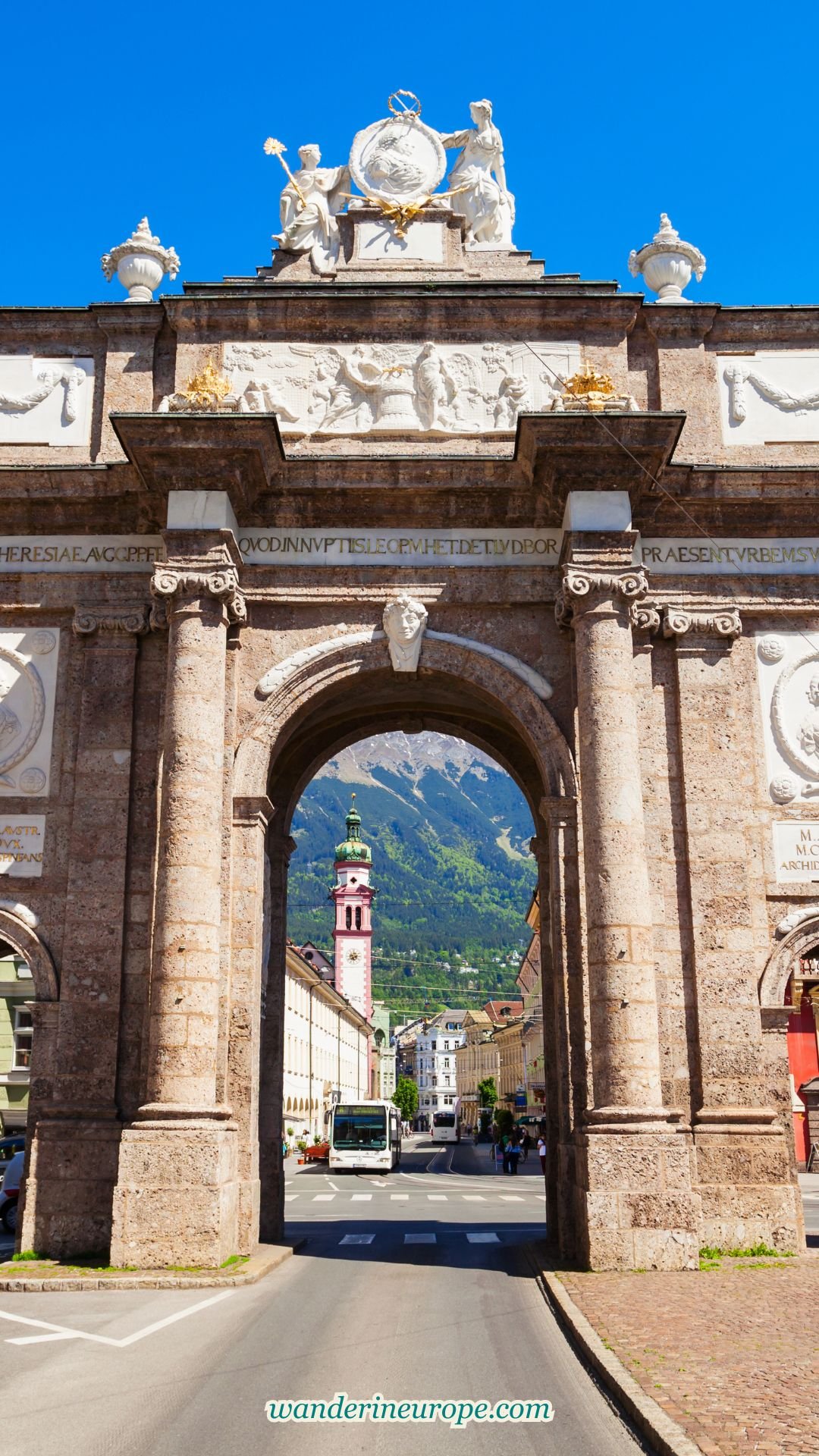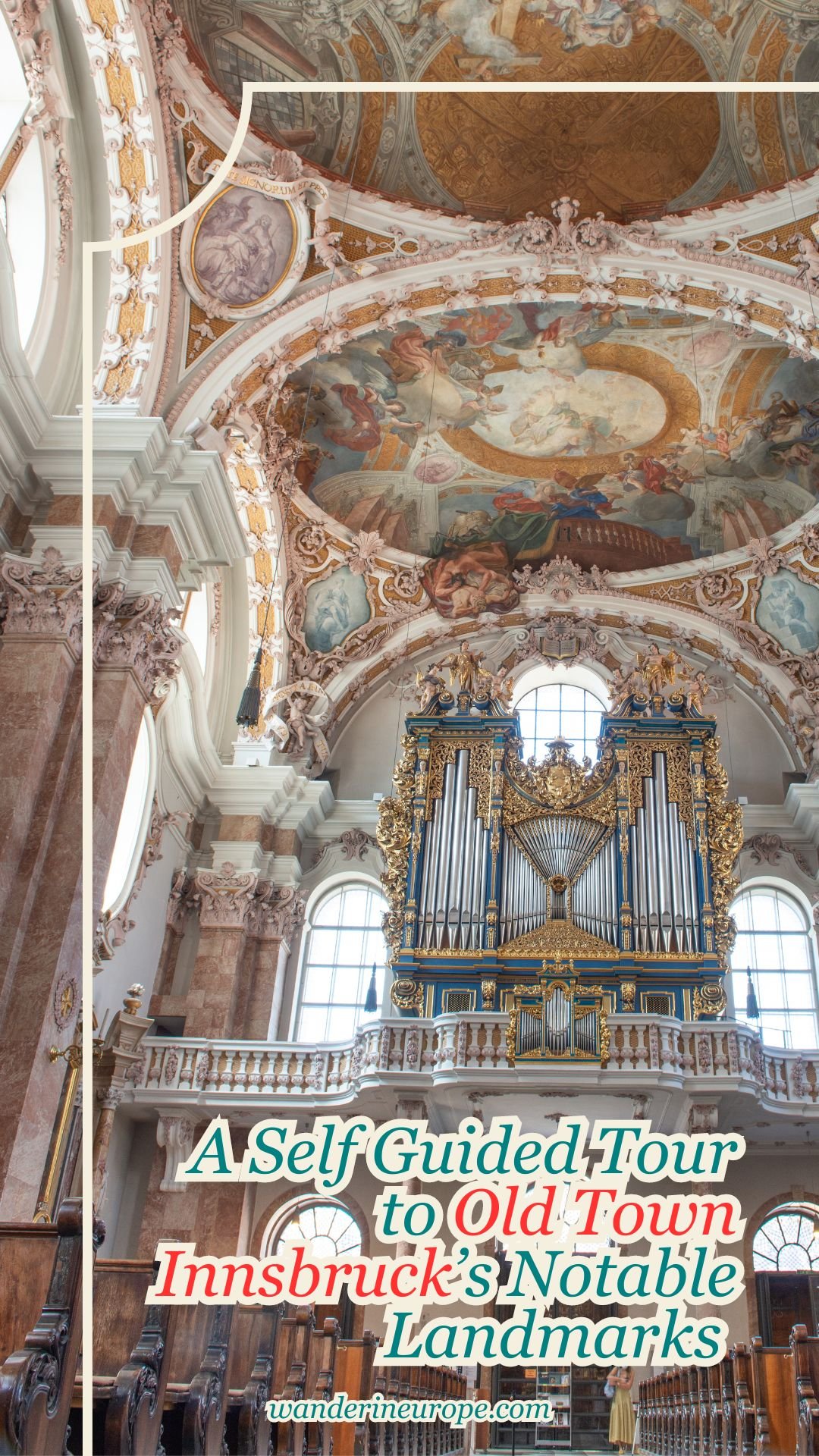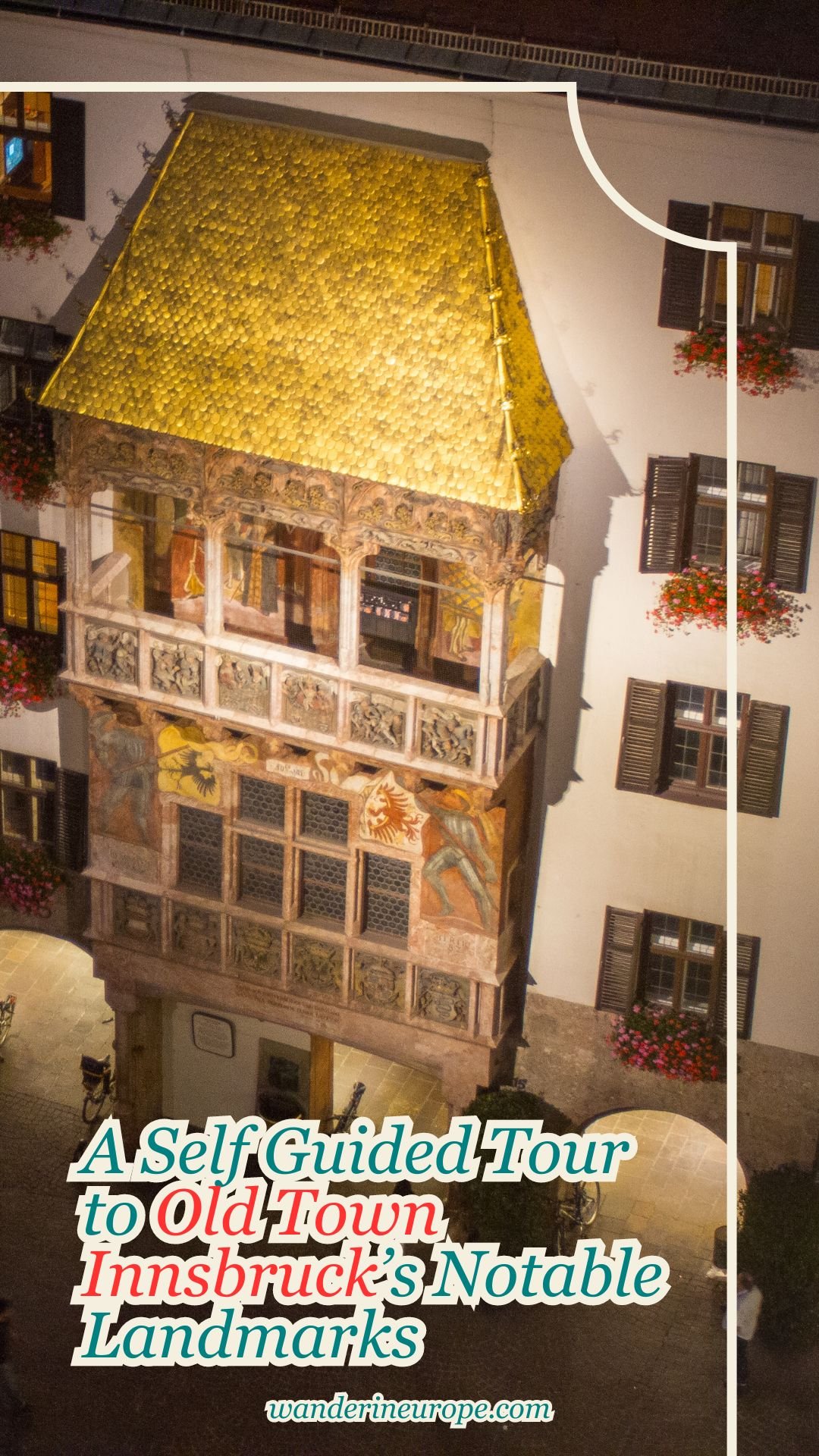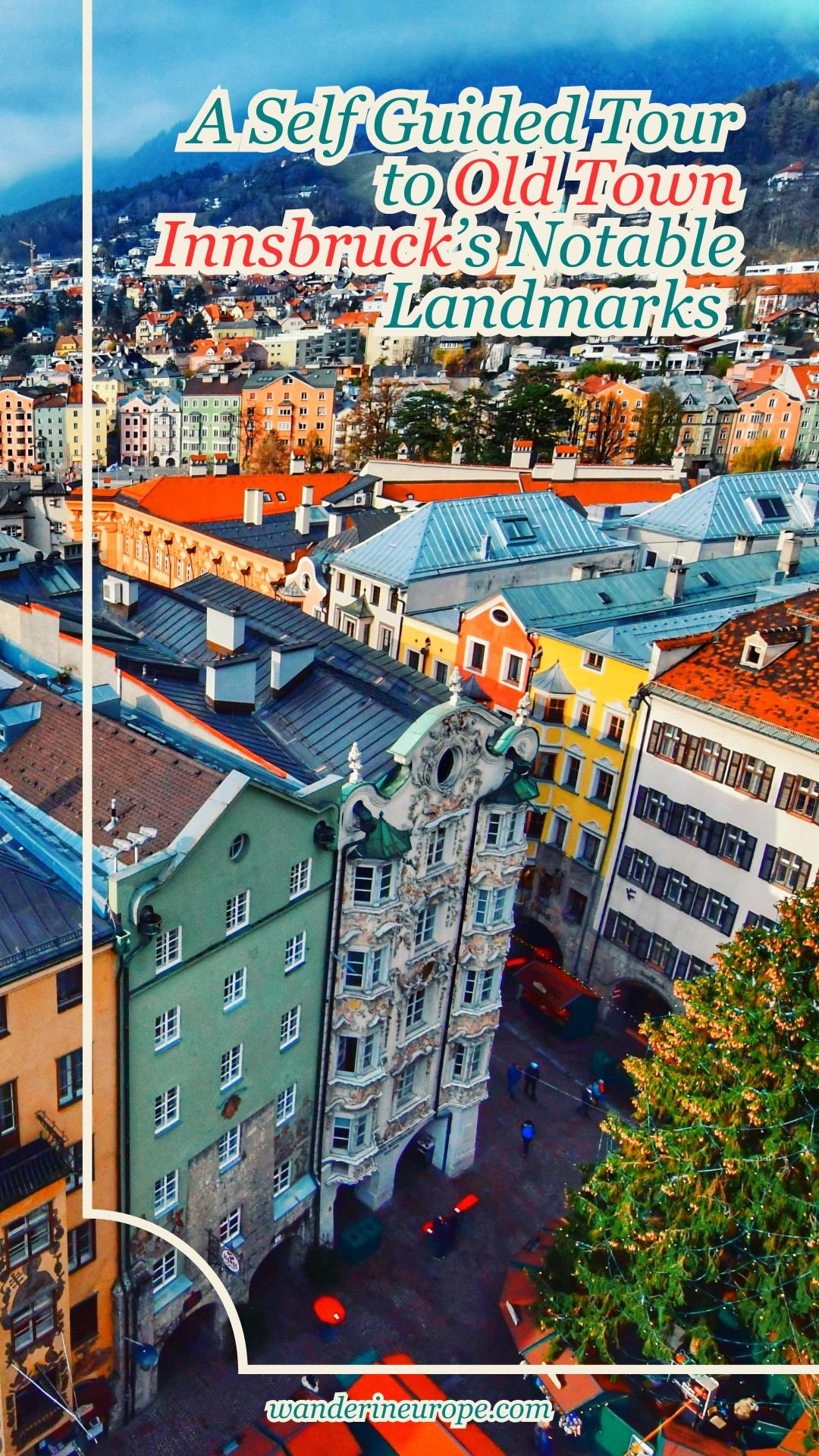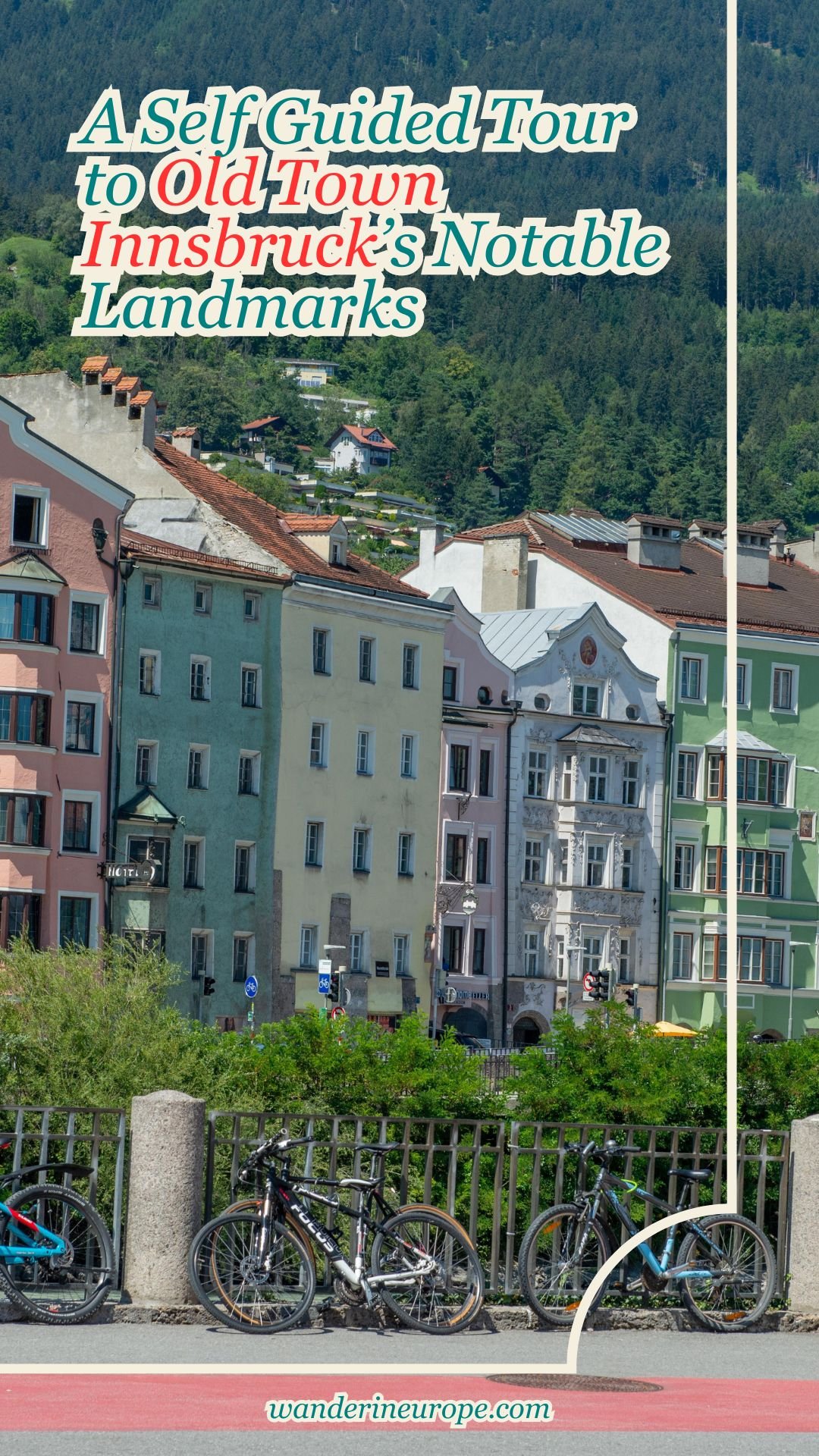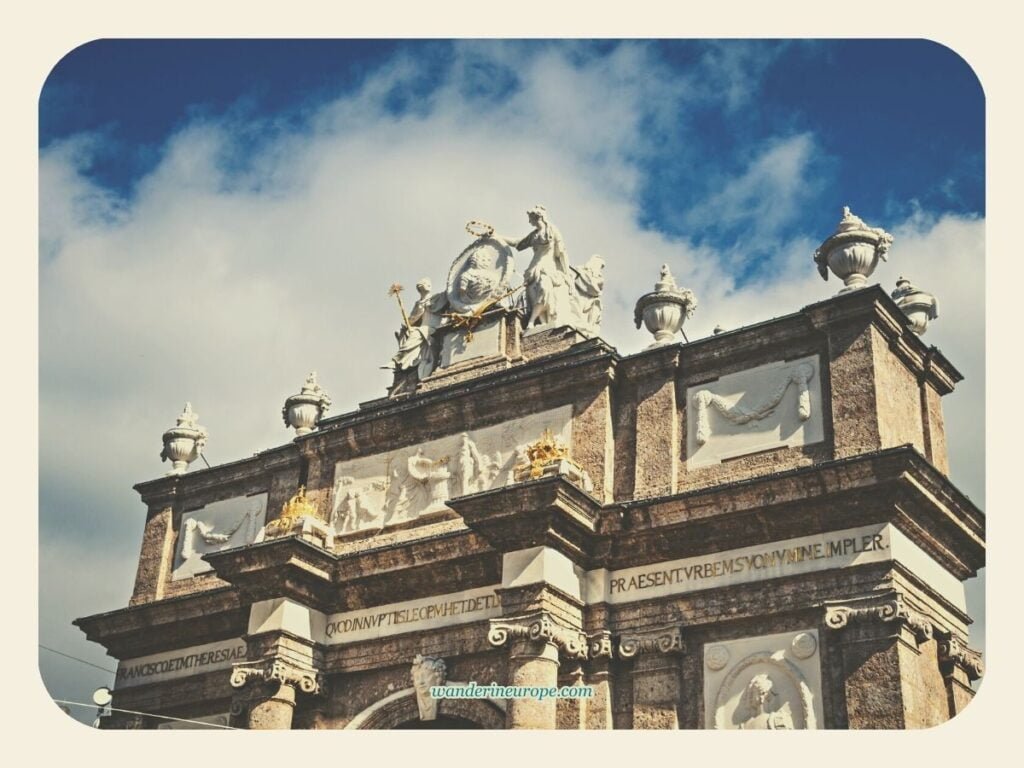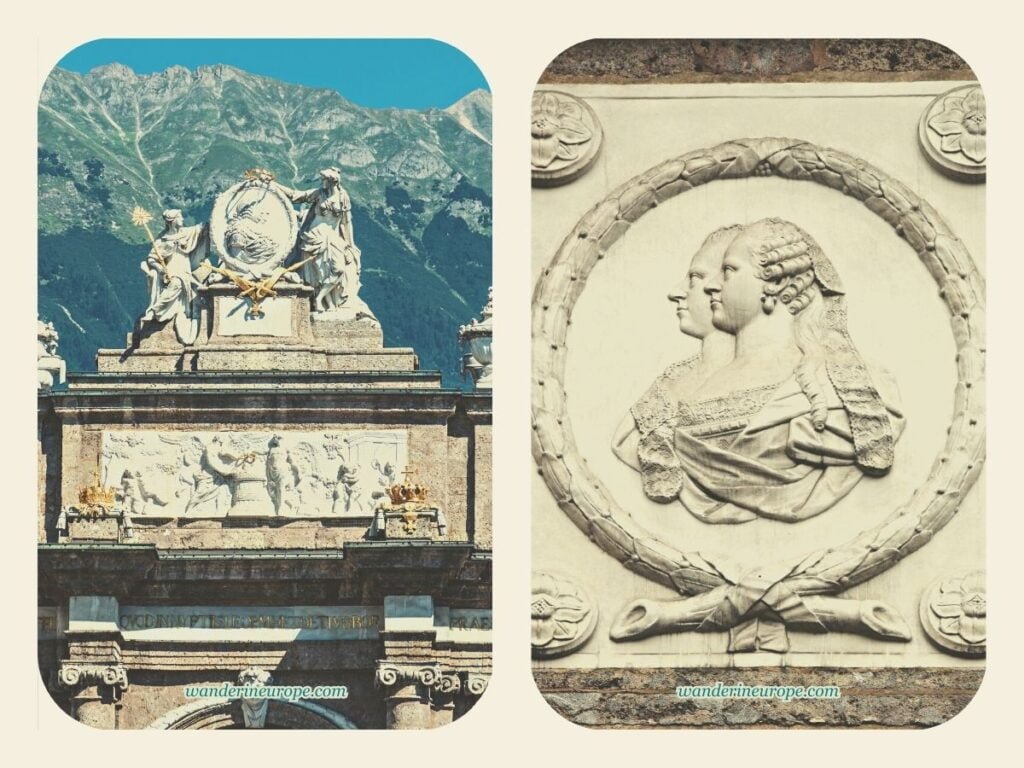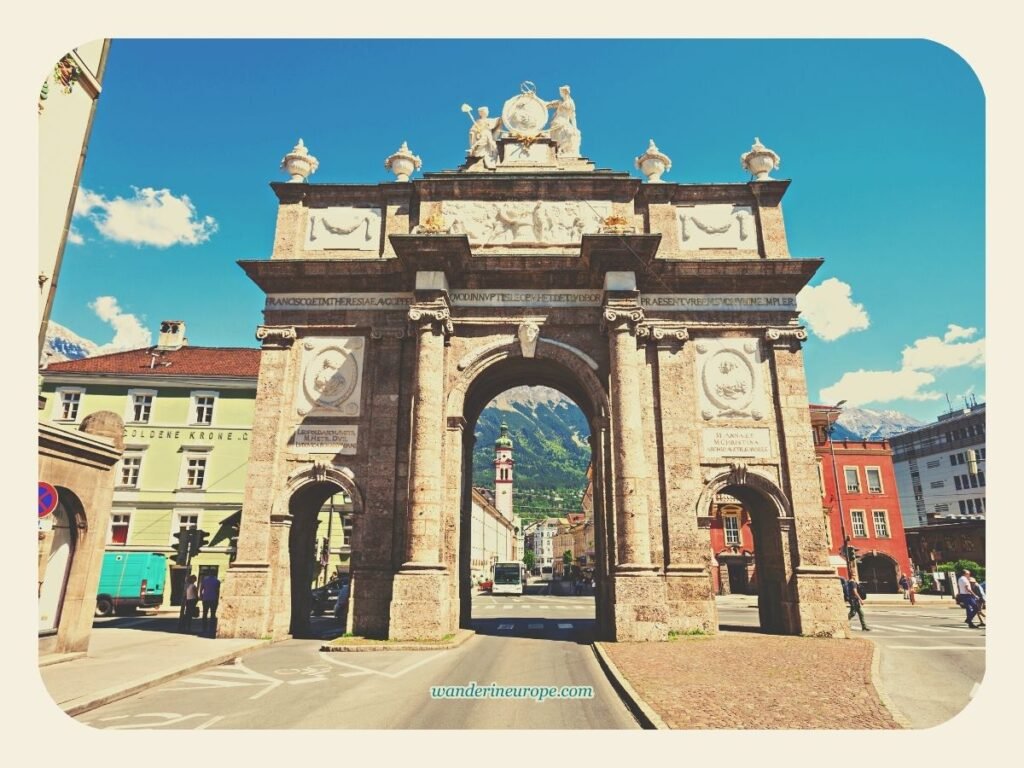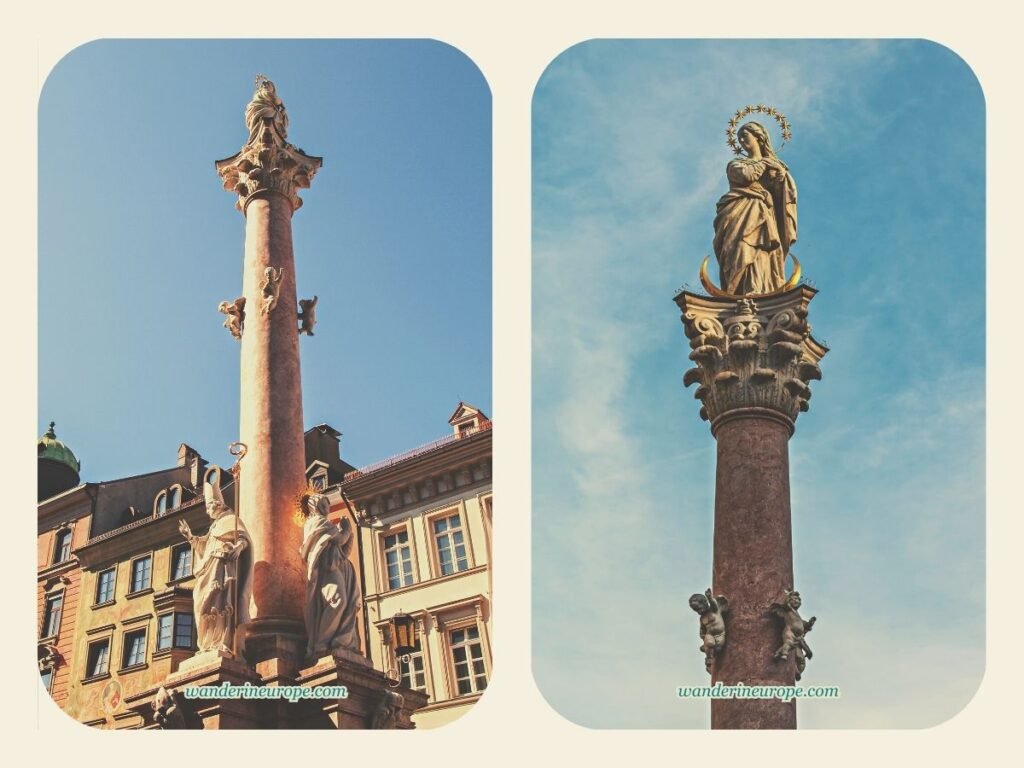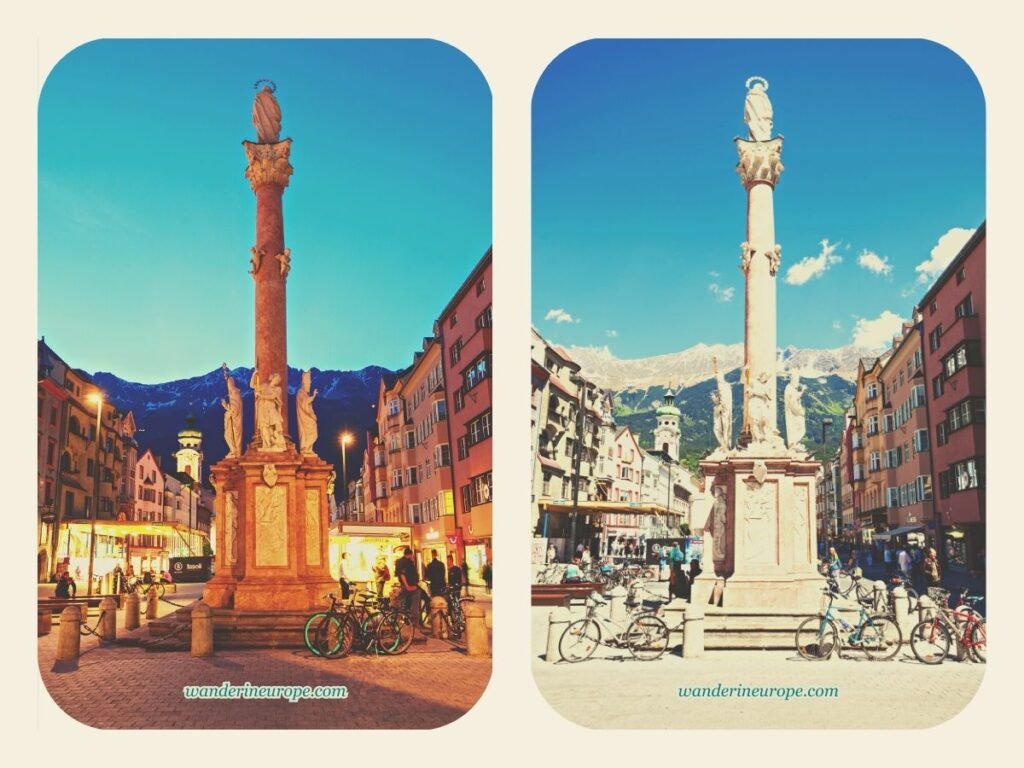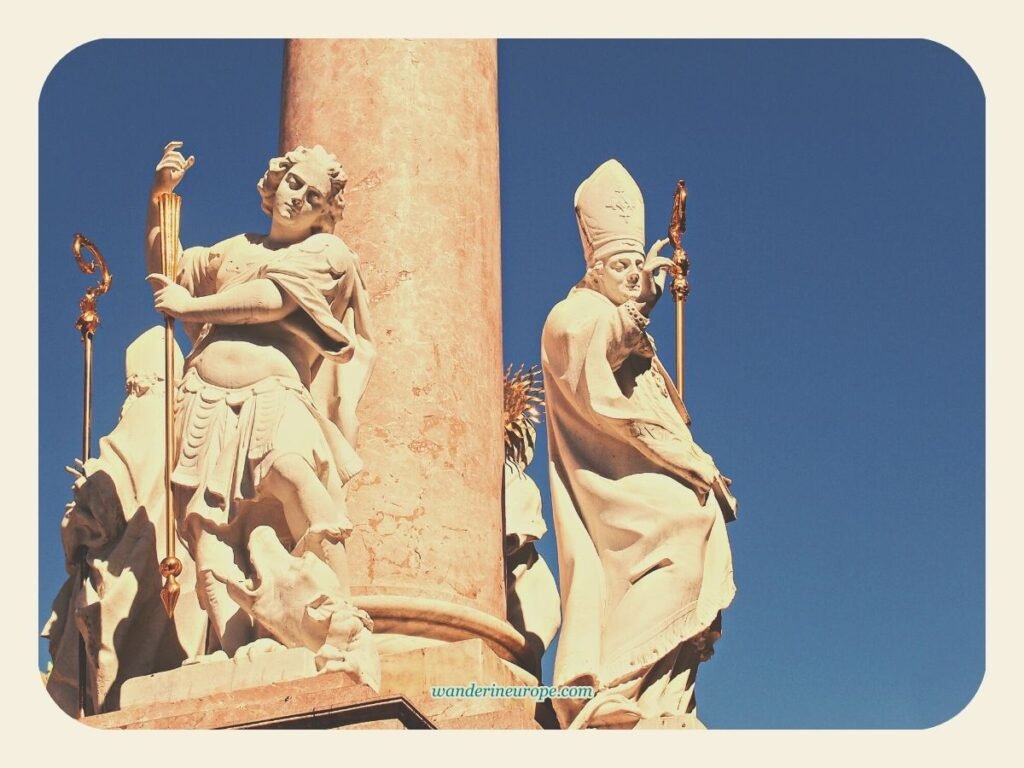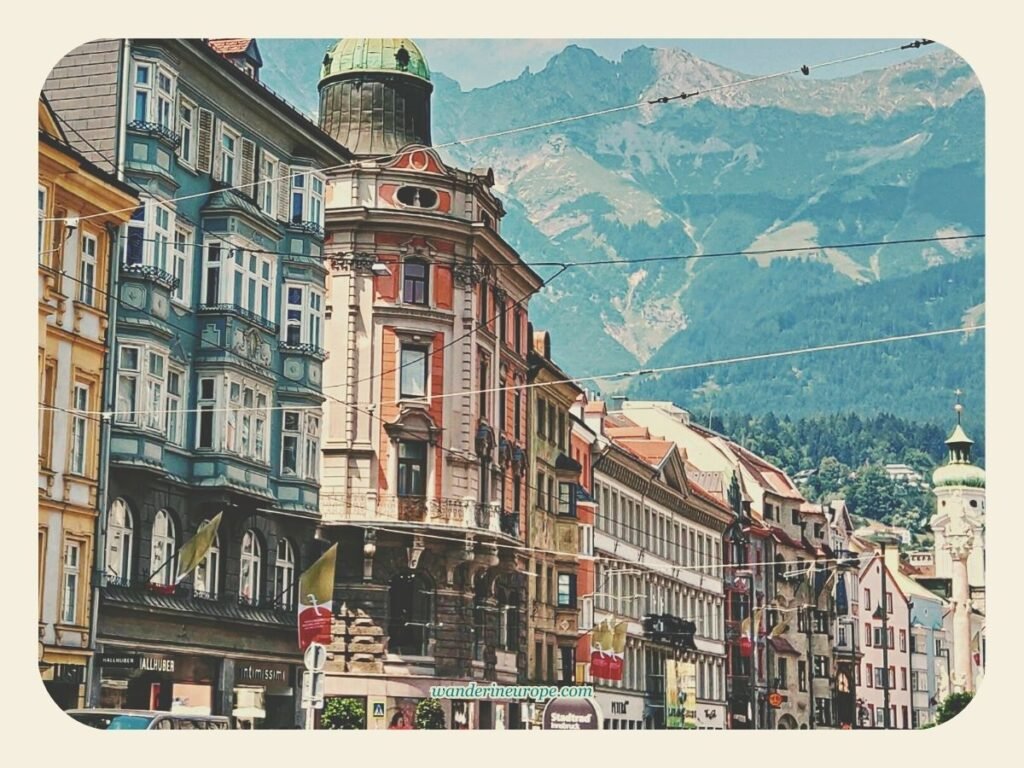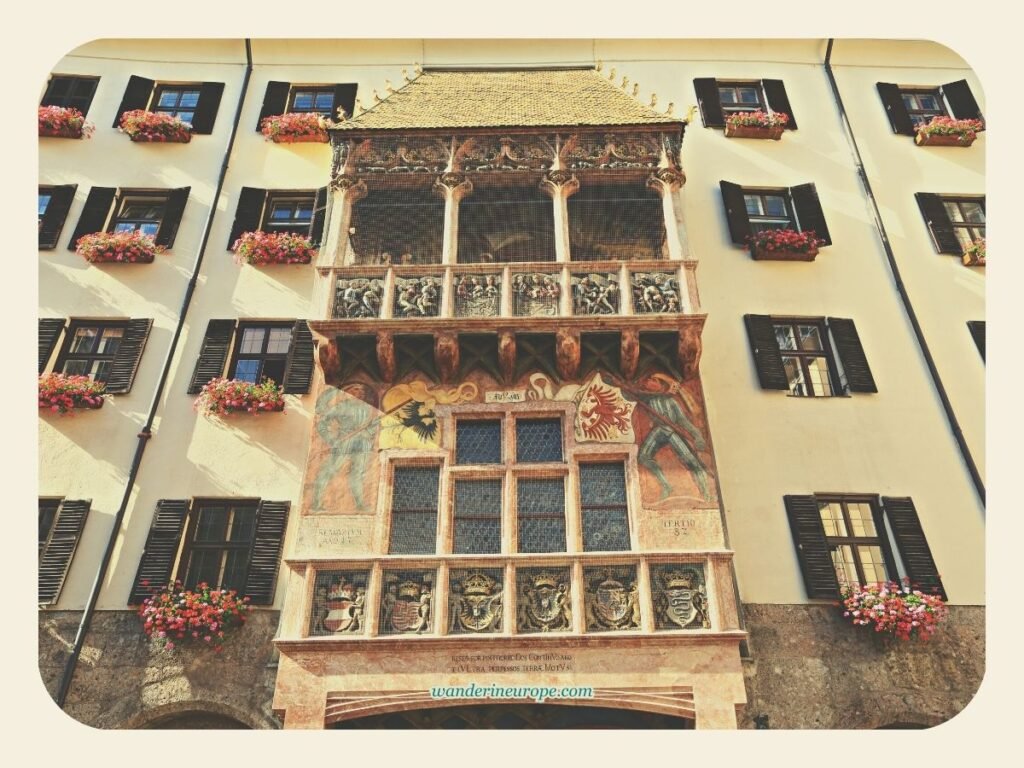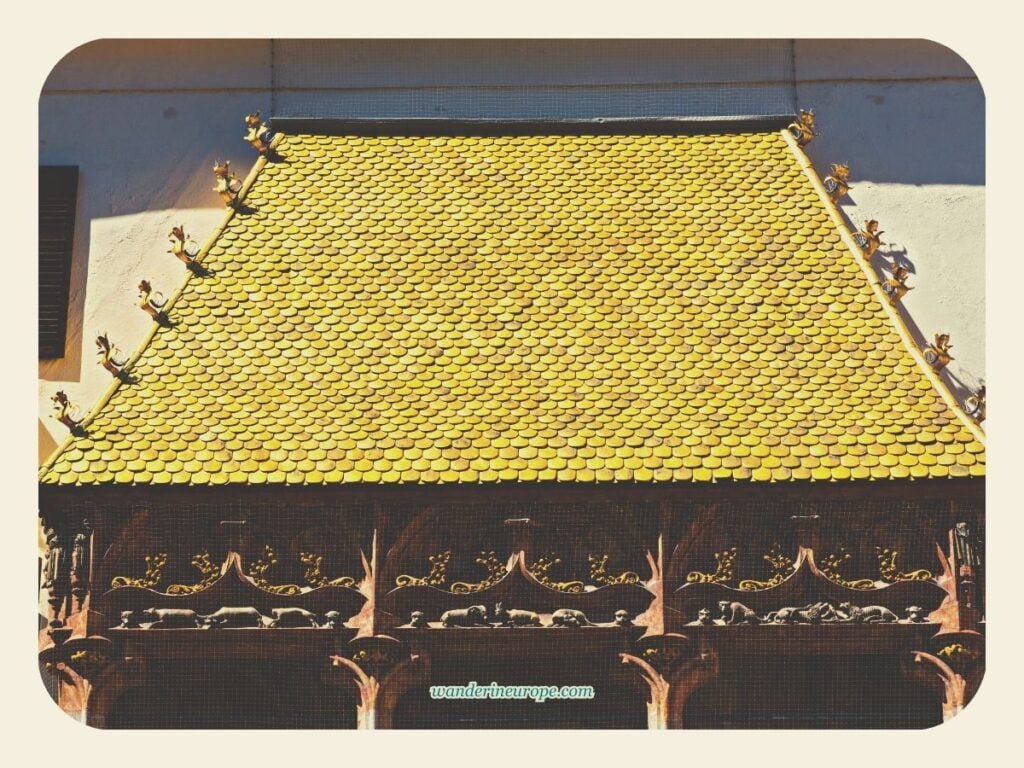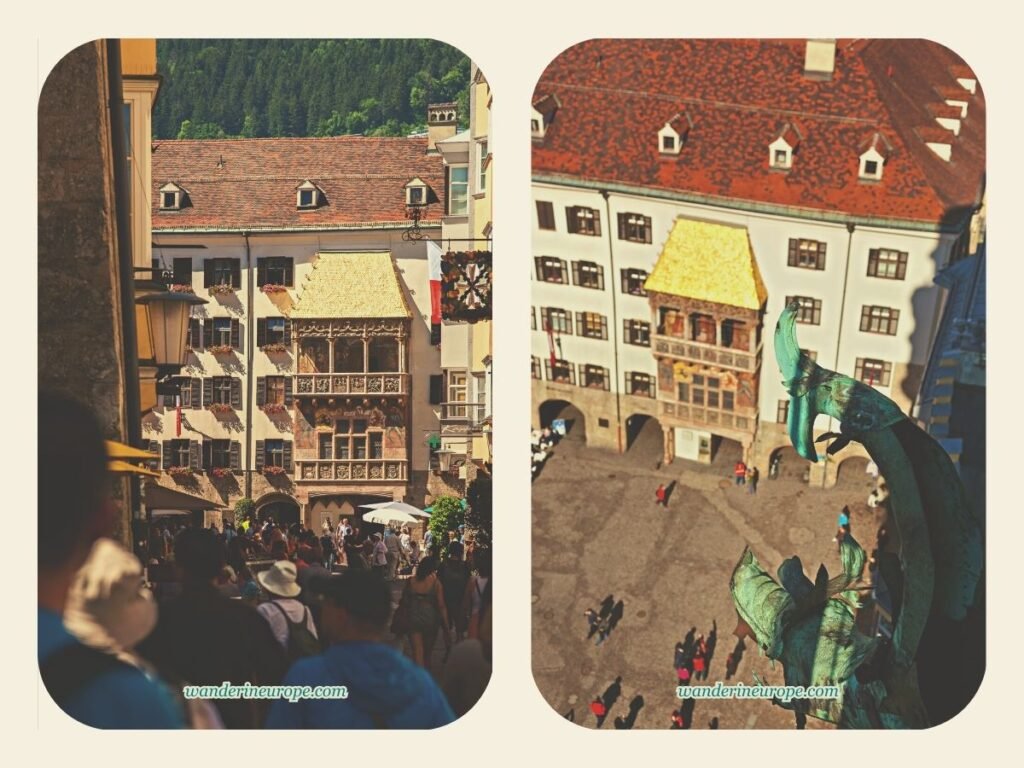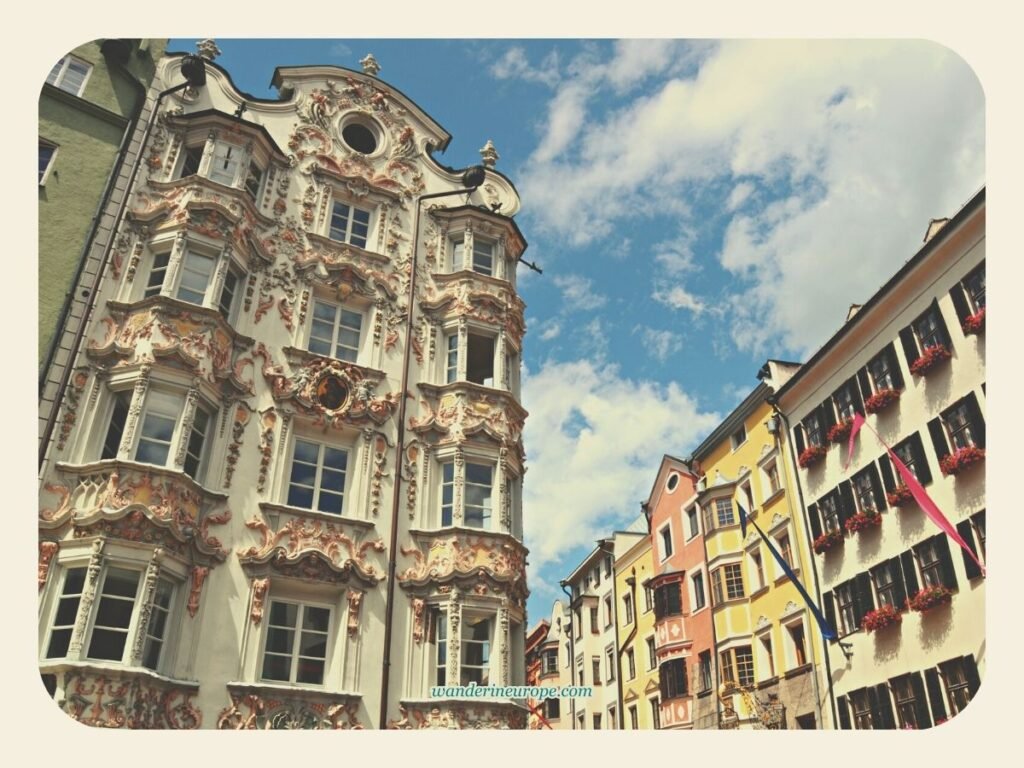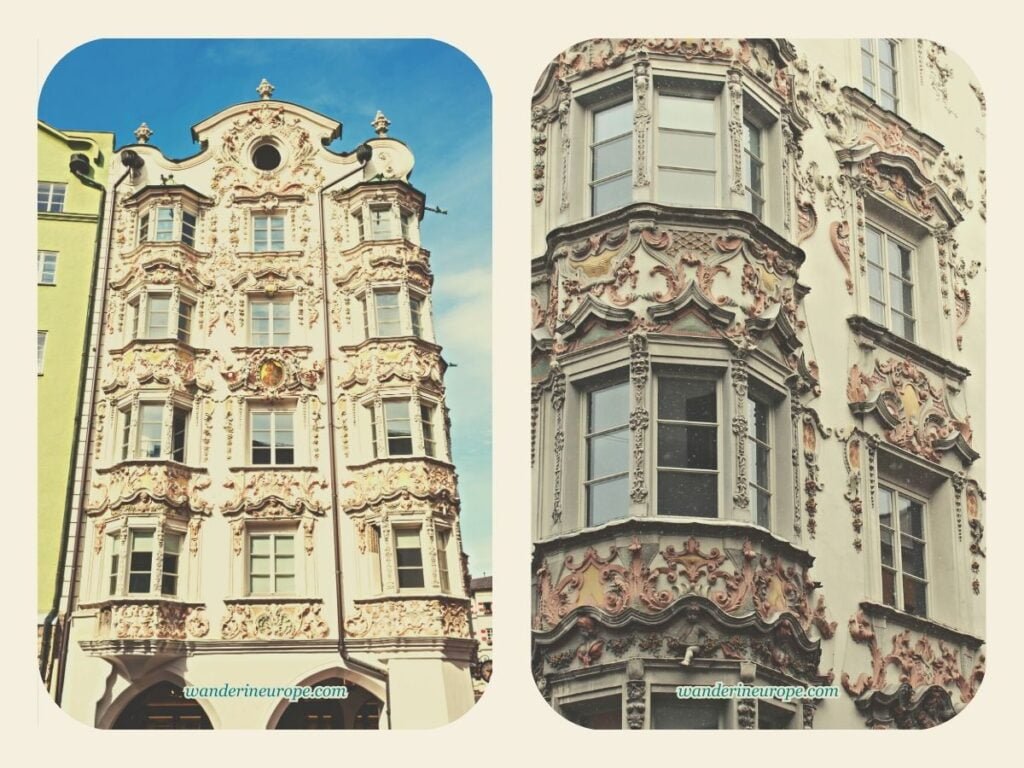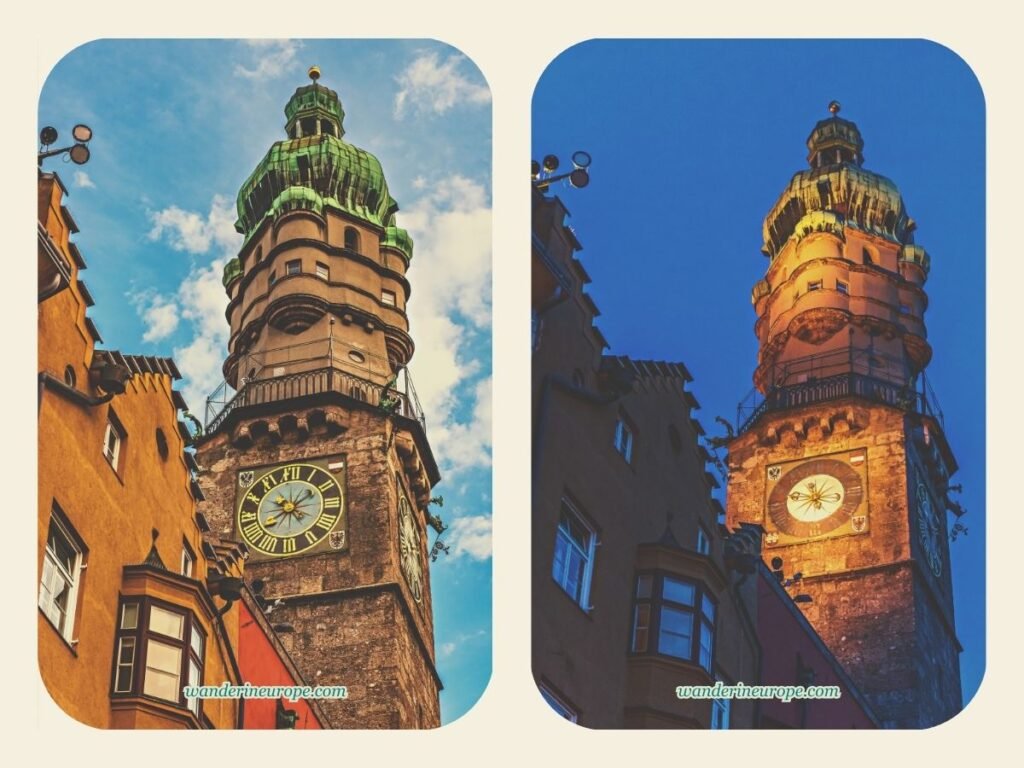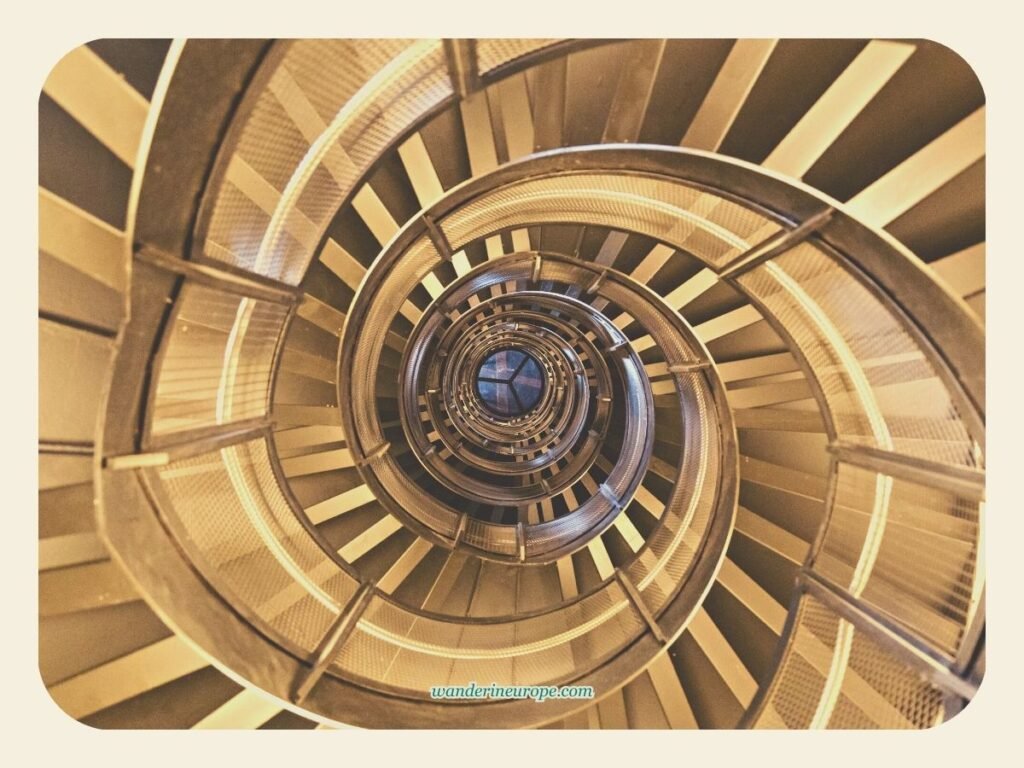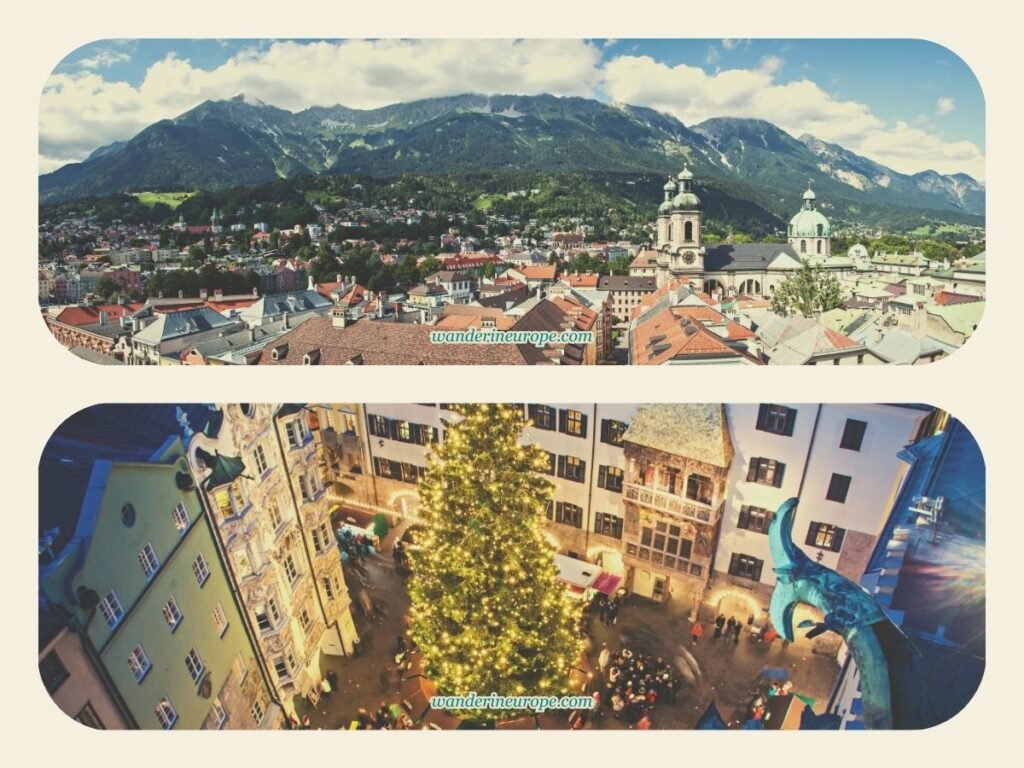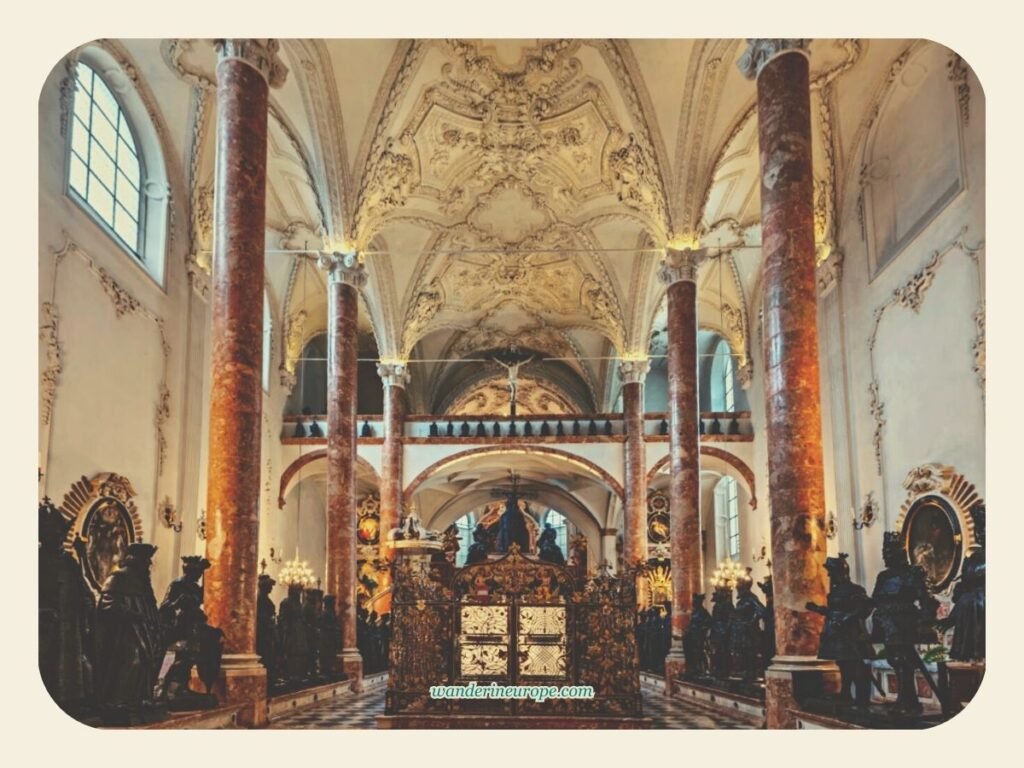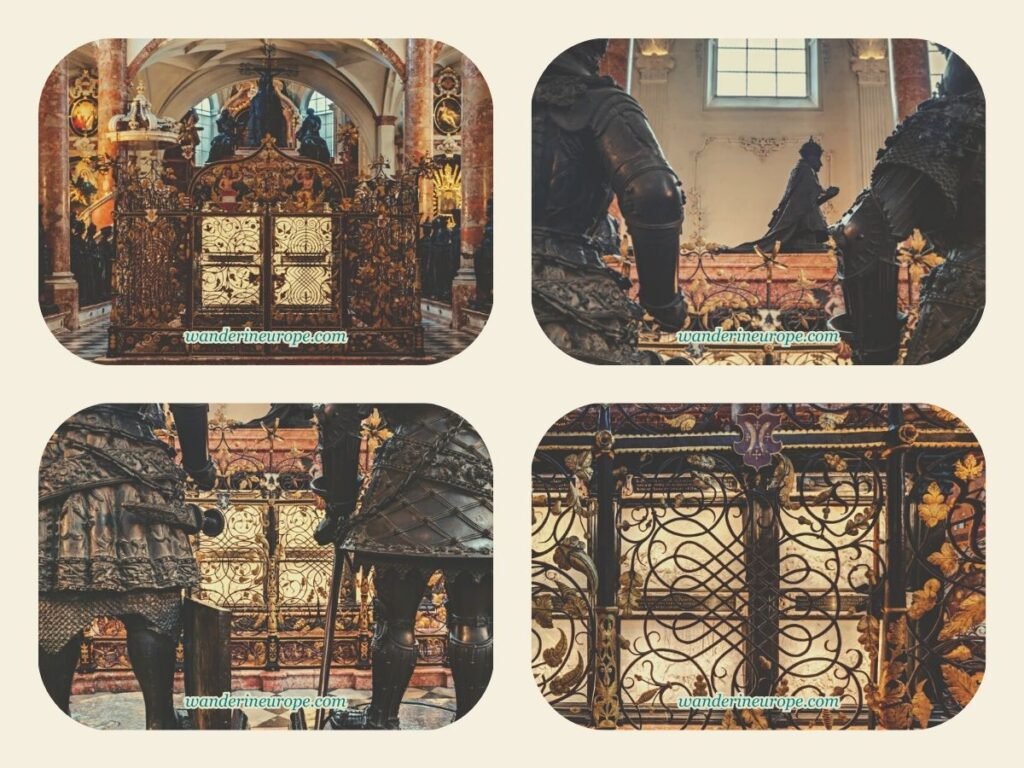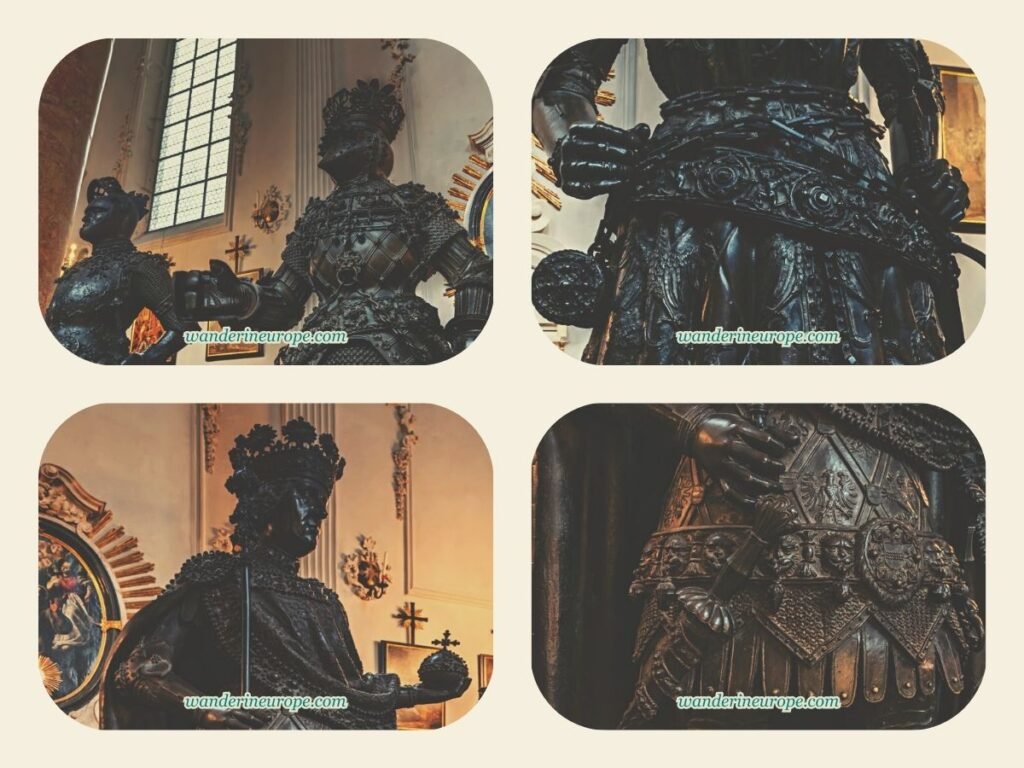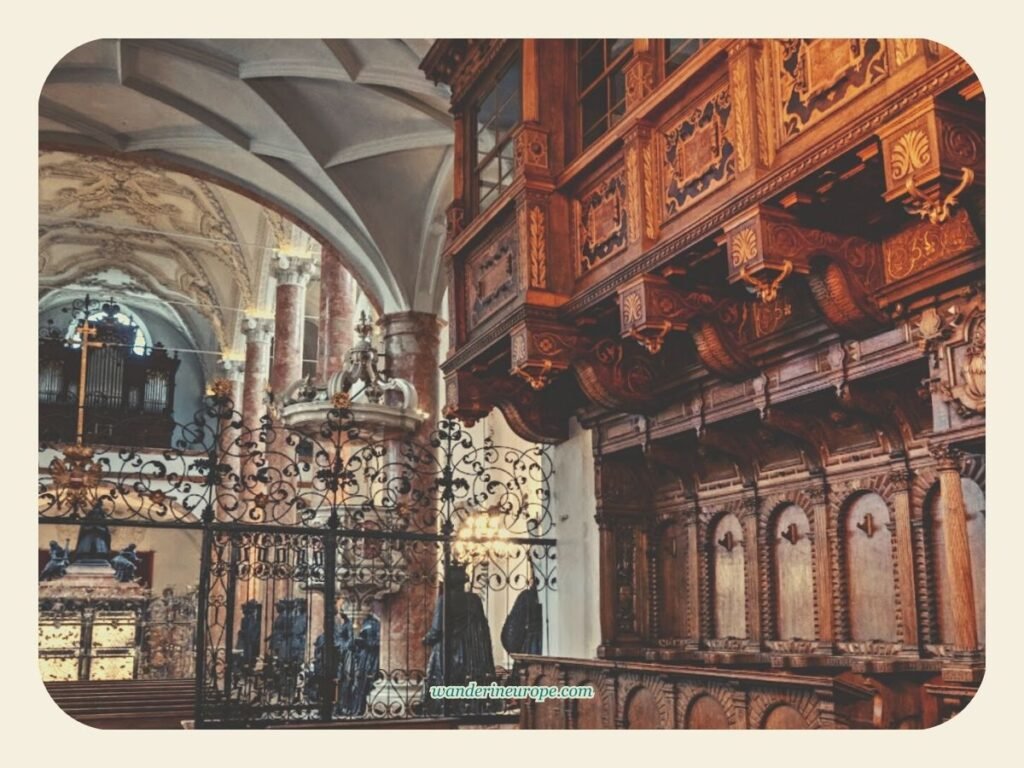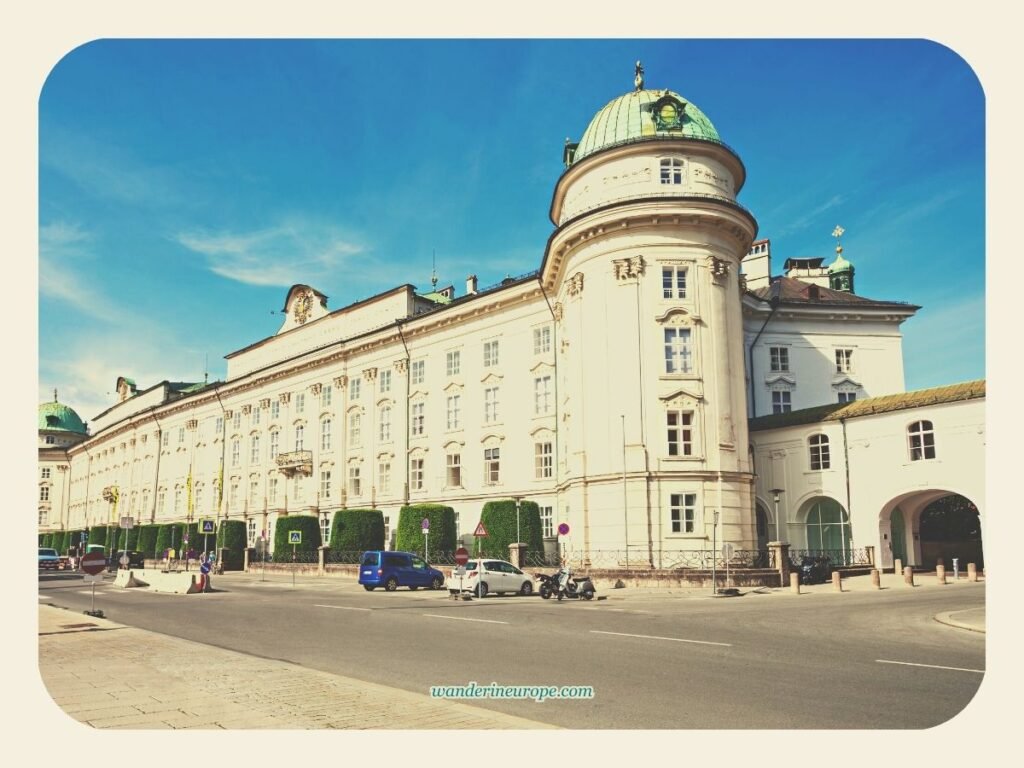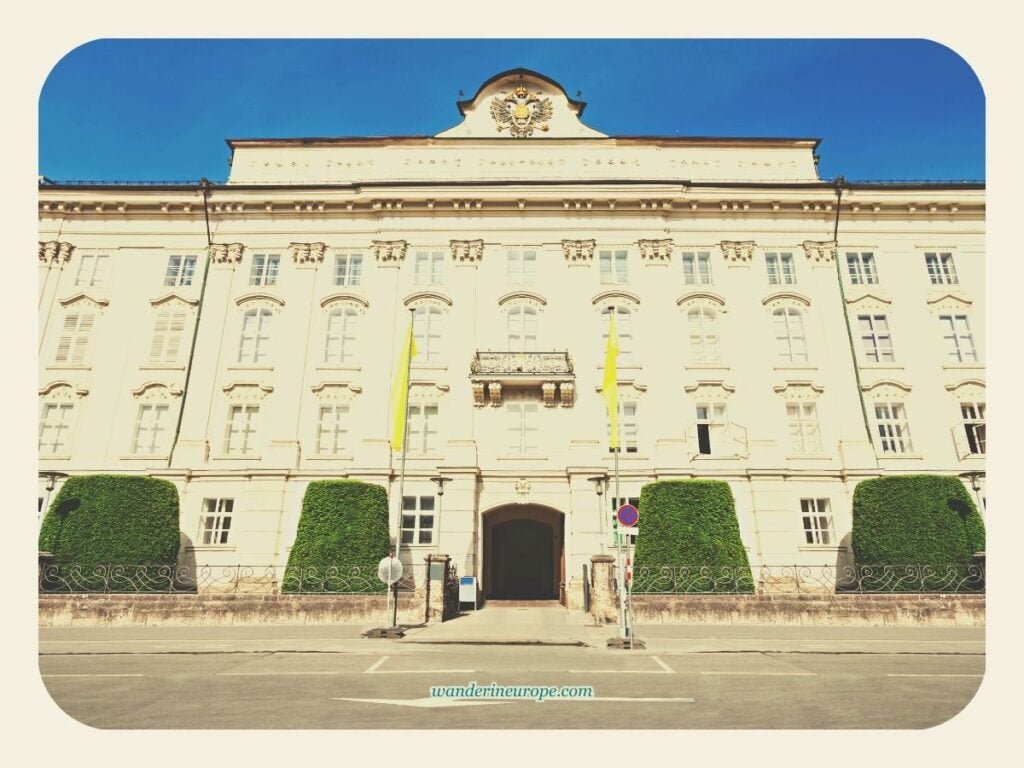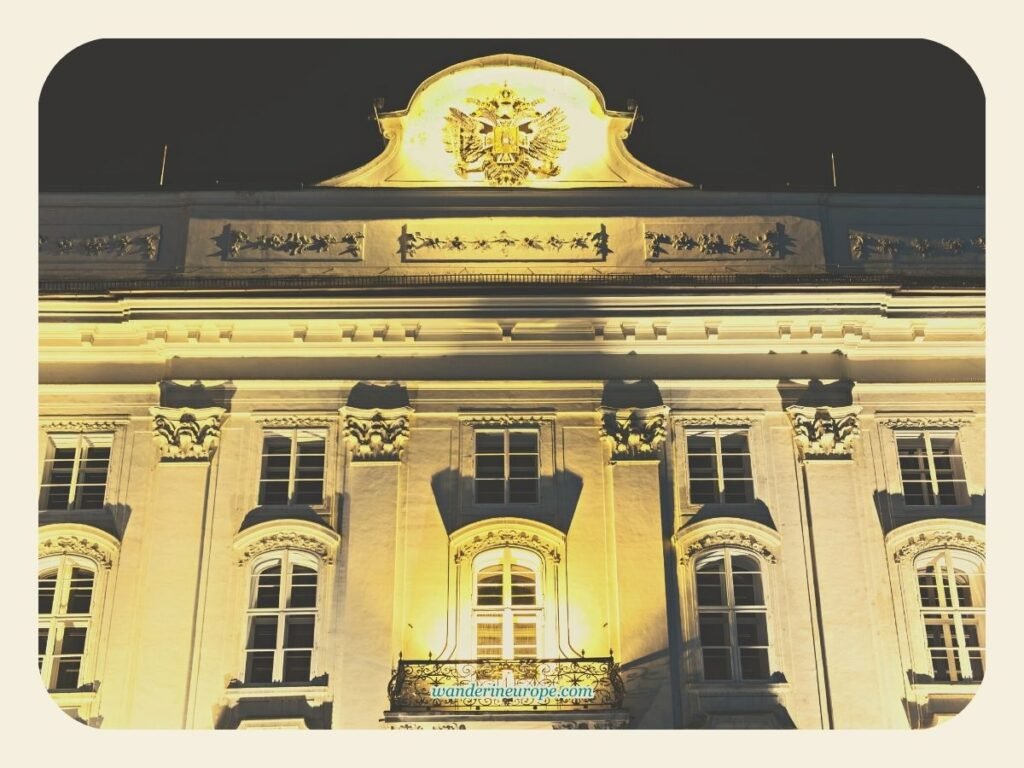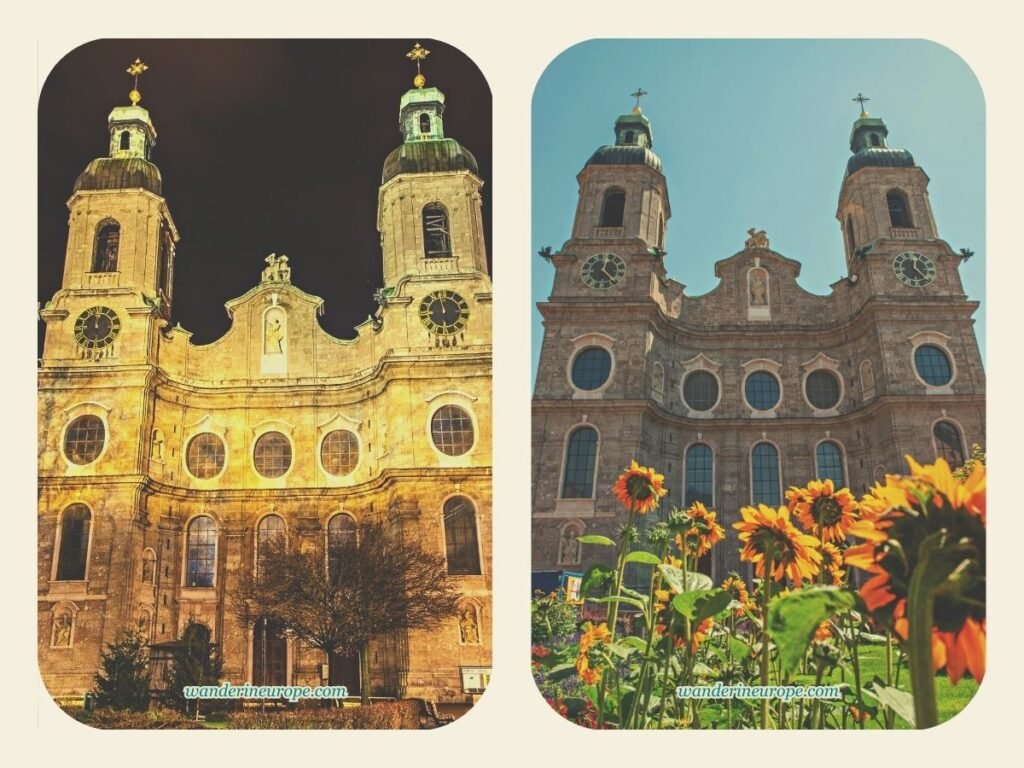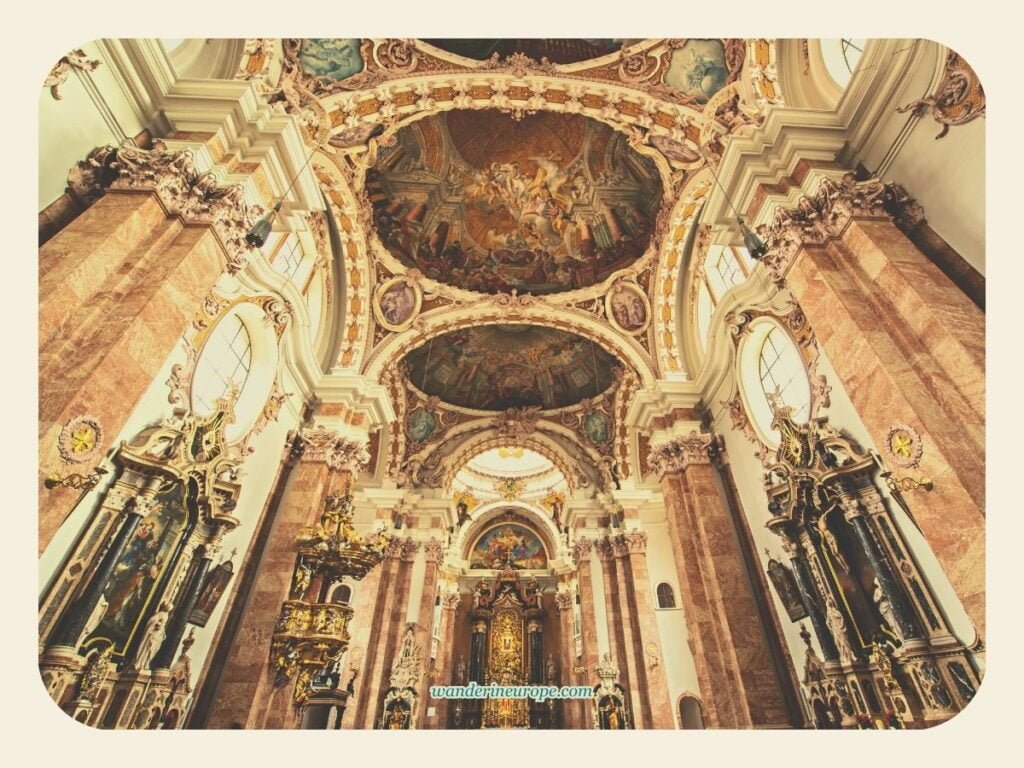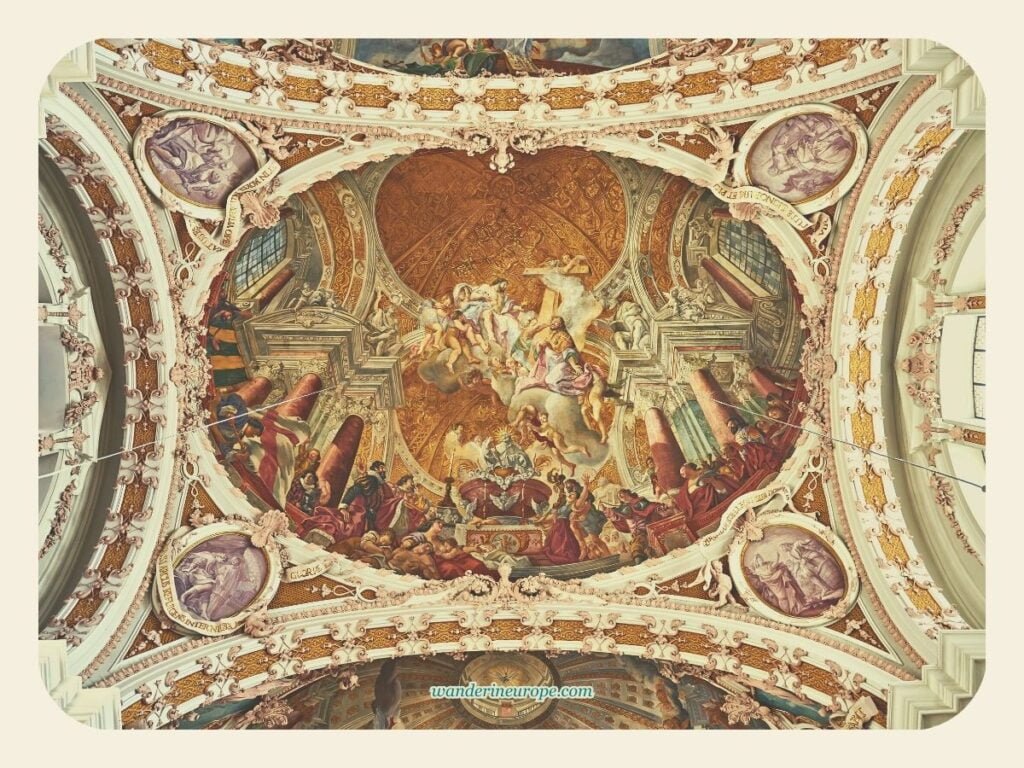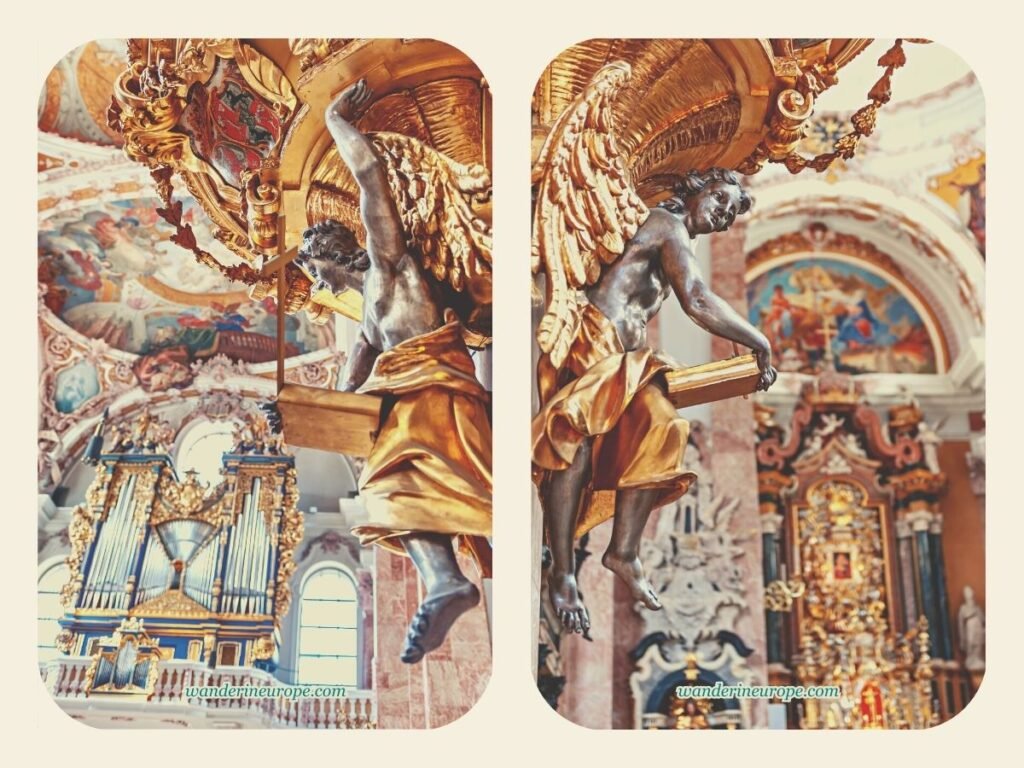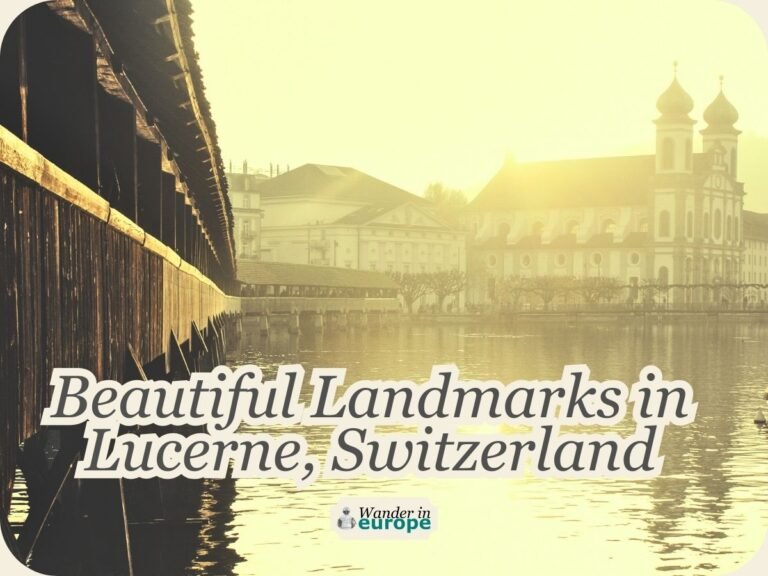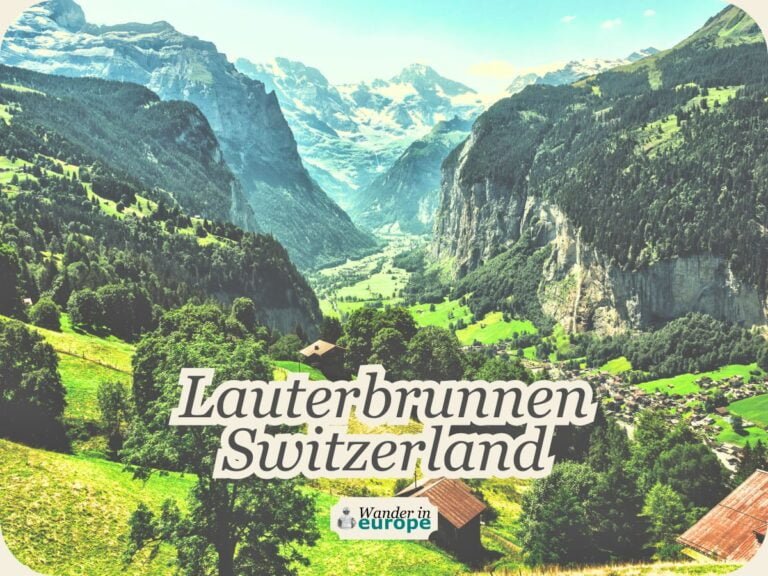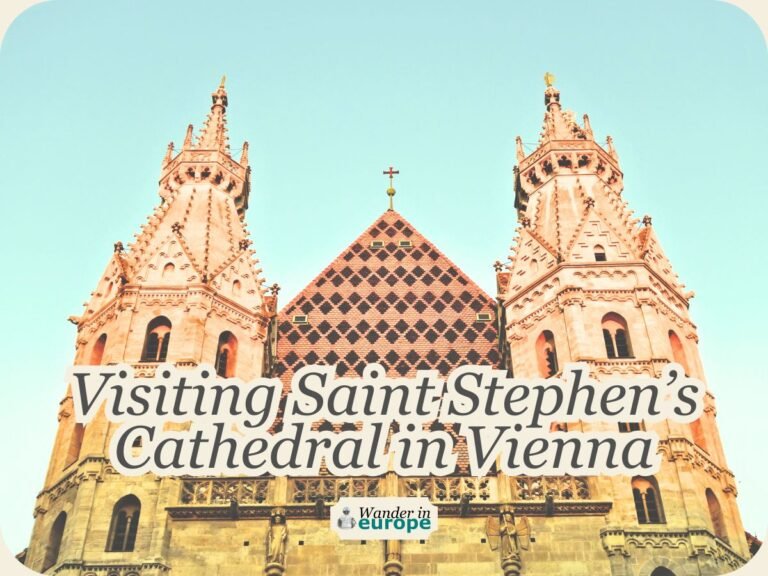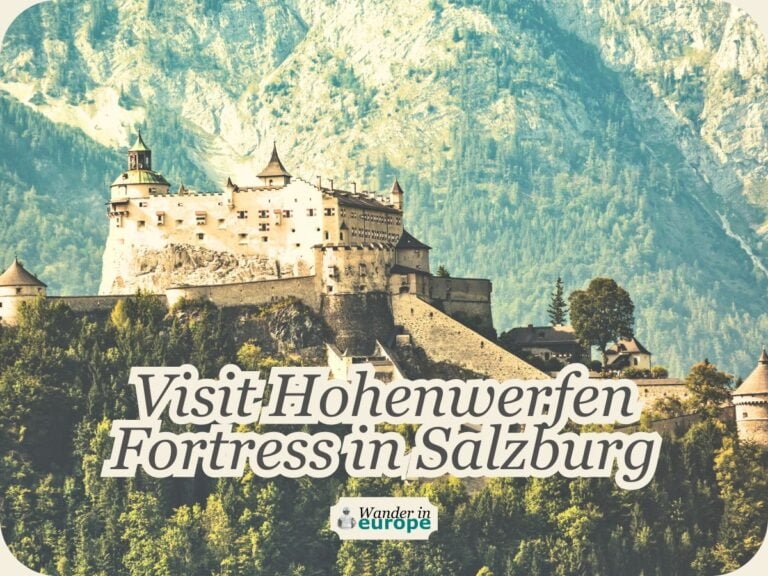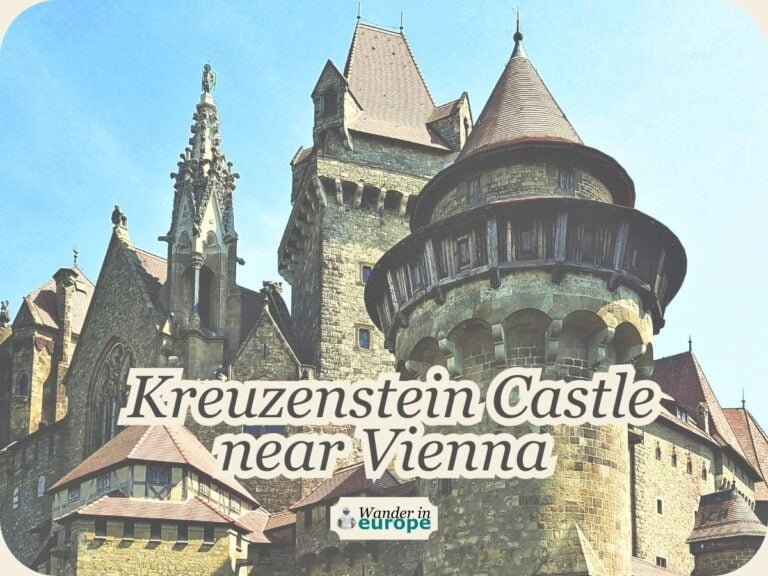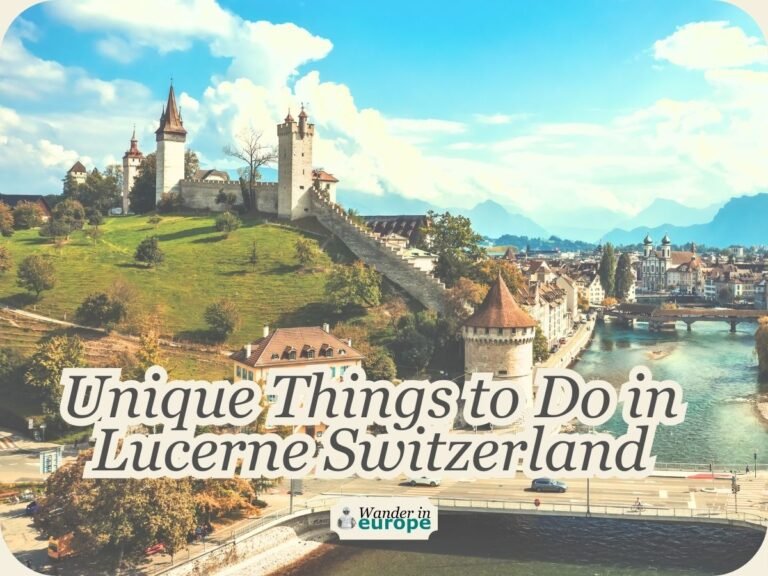A Self Guided Tour to Old Town Innsbruck’s Notable Landmarks
Notes & Disclaimer: (1) Google seems to be having a hiccup. Please use other search engines to find more guides and articles from WanderInEurope. (2) This website is reader supported. And this post might have affiliate links. This means we could earn a small commission if you make a qualifying purchase. No additional cost to you. More info: Disclosure.
Just by glancing at a topographical map of Austria, Innsbruck popped out at me, whispering tales of adventures and outdoor fun. So, I decided to explore it. And guess what? My intuition was spot on, thanks to the majestic Nordkette!
But that’s just the tip of the iceberg! Innsbruck is full of surprises. It has a mix of nature, beautiful architecture, and fascinating history. Visit the beautiful and insightful heritage sites like Ambras Castle and the Tirol Panorama Museum, and you’ll see what I mean. And yesss… from picture-perfect scenery to beautiful discoveries waiting around every corner, Innsbruck is a destination that wanderers would be thrilled to visit.
The main highlight of a visit to Innsbruck is, without a doubt, its Old Town. As a wanderer, I can vouch for it! After seeing its colorful buildings and eye-catching centuries-old heritage sites, I can confidently say the Old Town is an experience you would not want to miss in Innsbruck. Whether you’re spending a couple of days in Innsbruck or just visiting only for a day, I recommend putting Old Town Innsbruck at the top of your list!
Here’s the thing: while Old Town Innsbruck may not match the charm of other historic centers in the Alps, such as the Old City of Bern or Old Town Lucerne, it is nothing short of wander-worthy. It’s walkable, parts of it still exude a medieval flair, and unique historical landmarks are just a short walking distance from one another.
Are you wondering what they are and where they’re located? Allow me to guide you through the beautiful landmarks that Old Town Innsbruck has to offer. I’ll also point out a few hidden gems along the way! They’re arranged for you to easily follow on a self-guided walking tour of Old Town Innsbruck, which will be helpful as you explore the historic center.
Good to know
ESSENTIAL: How to get to Old Town Innsbruck
The Old Town Innsbruck, similar to European settlements dating back to medieval times, can be found in the heart of the city. It is specifically situated along the banks of the Inn River, from which it derived its name.
Getting to Old Town Innsbruck couldn’t be simpler if you’re arriving at the city’s central train station. Maria-Theresien-Strasse, one of the most beautiful streets in Old Town Innsbruck, is a leisurely walk less than 10 minutes from the train station. However, if you’re flying into Innsbruck, reaching the Old Town requires an additional step. From the airport’s main building, you can simply hop on bus route F to get to Innsbruck’s main station. The journey typically takes around 20 minutes

GOOD TO SEE: Map of Old Town Innsbruck + Walking route to different landmarks (with exact location)
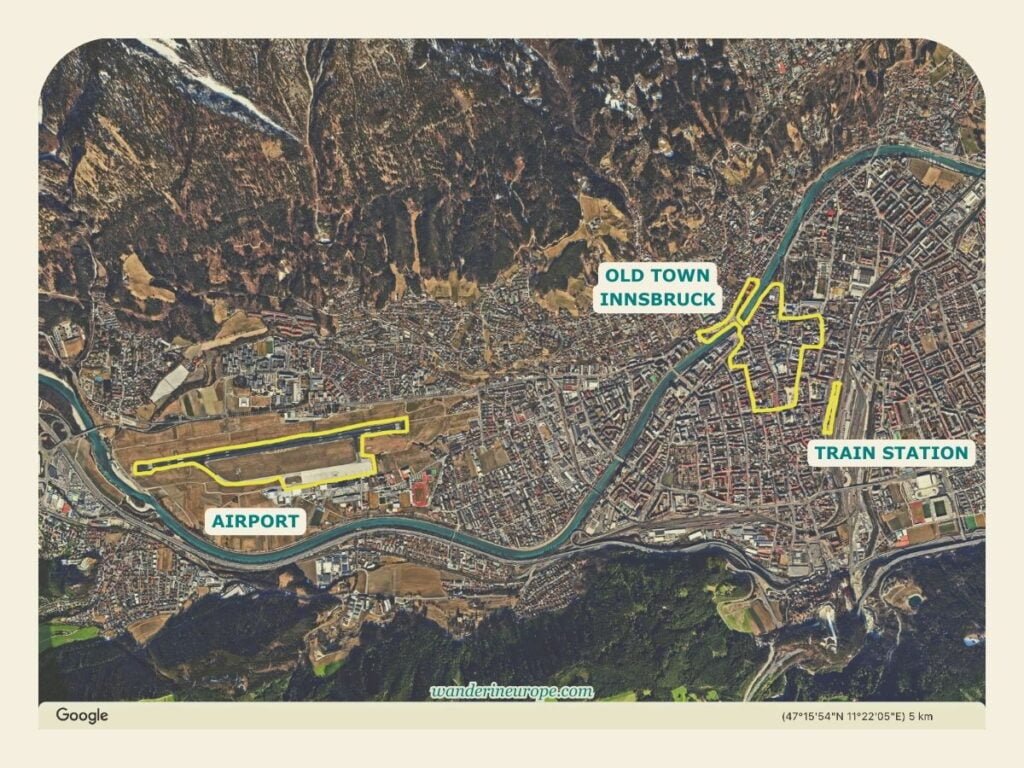
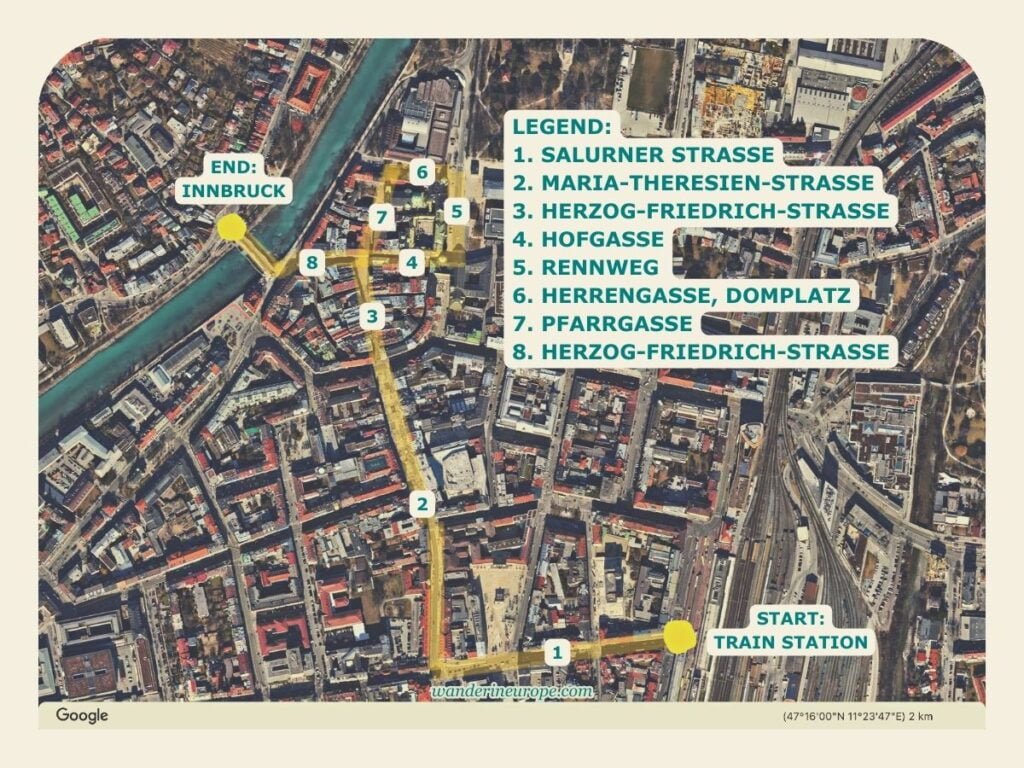
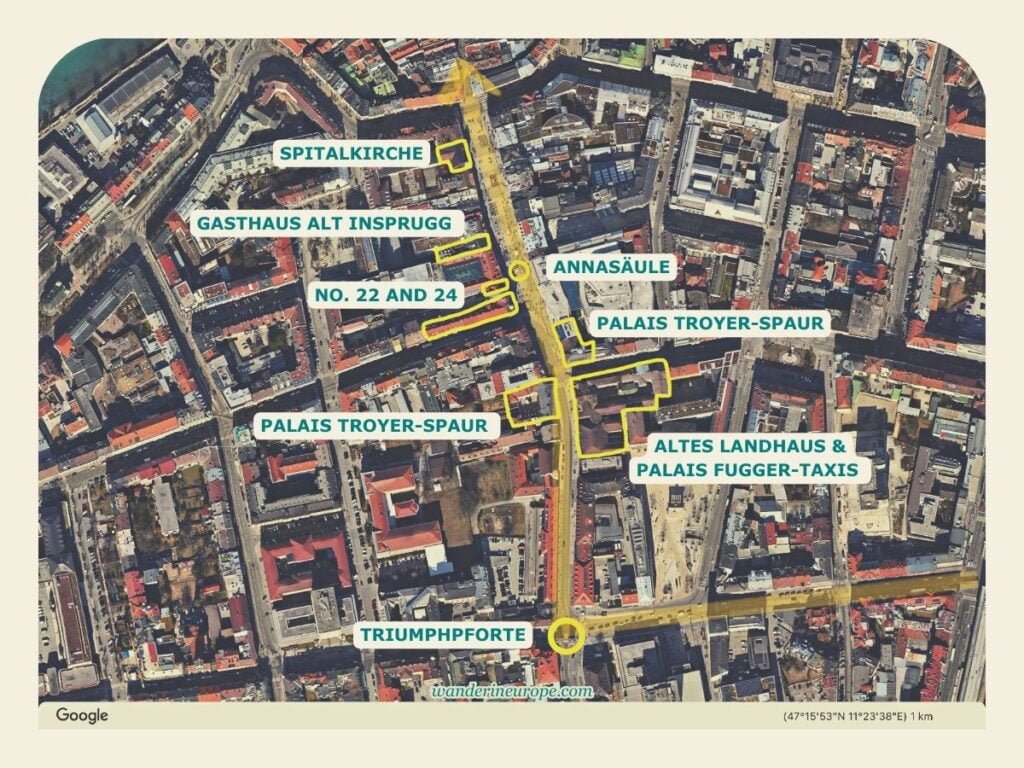
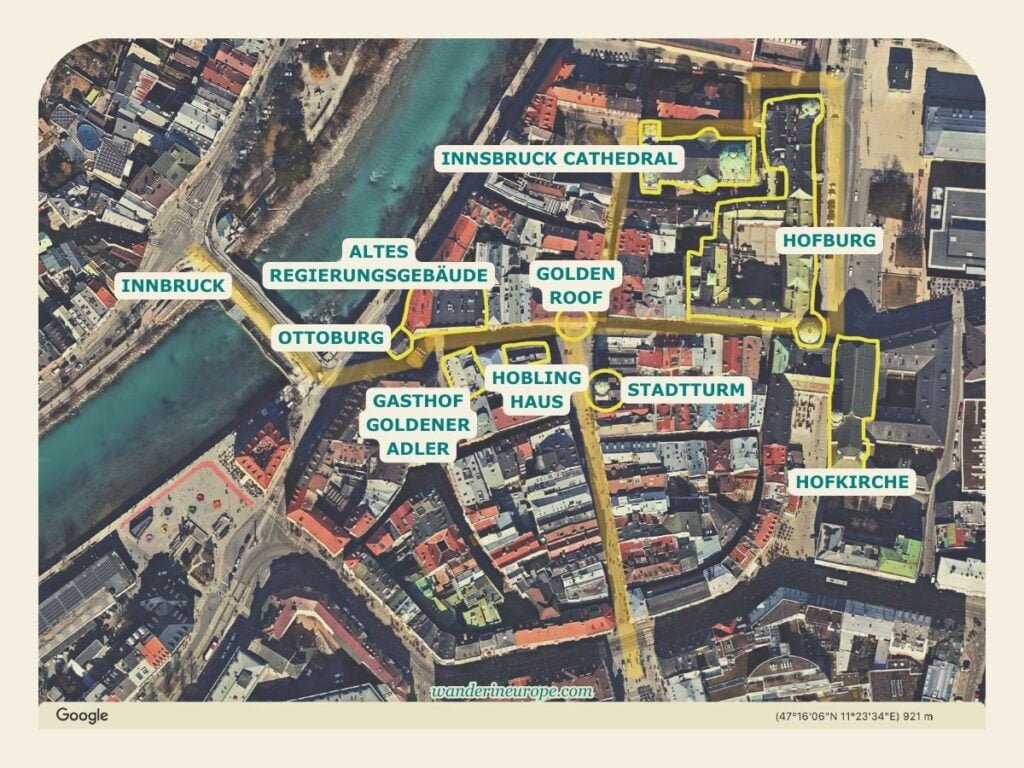

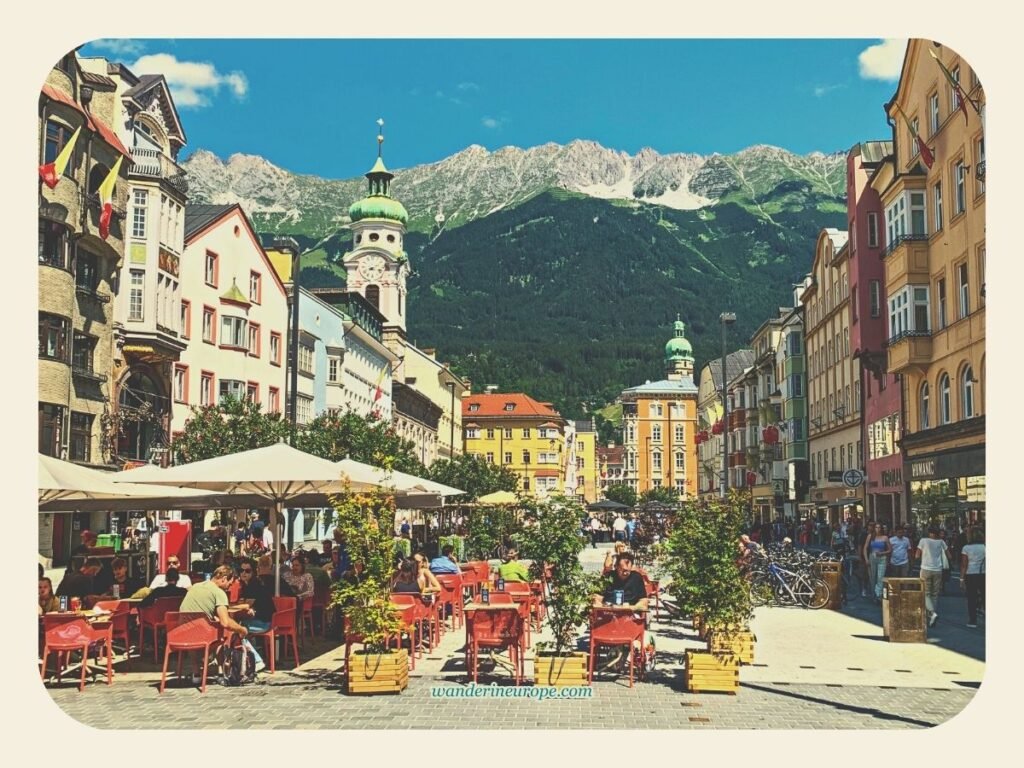
Tip: Unlock the best of Innsbruck with the City Card! This all-in-one pass grants you access to top attractions like the Golden Roof museum, Stadtturm, Hofkirche, and Hofburg (all included in this self-guided walking tour). Plus, enjoy free public transport, hop-on hop-off bus service, and even Nordkette cable car rides. It’s not just about savings, it’s about experiencing Innsbruck seamlessly.
Destination 1. Triumphpforte
Among the must-see landmarks in Innsbruck, the Triumphpforte, or the Triumphal Arch, is the closest to the train station. From the station, you can easily reach the southern end of Maria-Theresien-Straße in less than 10 minutes, where the Triumphpforte is located.


More details about Triumphpforte + photography tips
Standing tall at the southern end of Maria-Theresein-Strasse, the Triumphpforte not only welcomes you to the enchanting corners of Old Town Innsbruck but also offers a captivating glimpse into the city’s remarkable past. Triumphpforte is one of Innsbruck’s most famous landmarks, and this should be the reason why.
Before entering Maria-Theresein-Strasse through the Triumphpforte, I suggest spending a little time appreciating the architecture and design of the arch. After all, this 18th-century landmark is also a moment where you can already discover pieces of Austrian history.
Both facades of the Triumphpforte are richly elaborated with inscriptions and intricate marble reliefs. Fascinatingly, they depict contrasting meanings—happiness and grief—from two events in the history of Austria that took place nearly at the same time: the wedding of Archduke Leopold and Maria Luisa and the death of Francis Stephen, the father of Leopold.
In my opinion, the best viewing point for the Triumphpforte is from the south. From this angle, you can see Triumphpforte adorned with festive reliefs depicting portraits of various royals such as Archduke Leopold, Spanish Princess Maria Luisa, and others. If the weather is fantastic, you can capture photographs of the Triumphpforte along with the majestic mountains of Nordkette in the background when viewing from the south.
On the flip side, you can see a memorial motif commemorating the death of an emperor. Overall, by checking both sides of the Triumphpforte, you can find several portraits of different royals. Below are the ones I saw:
- Empress Maria Theresa and Francis Stephen
- Archduke Leopold and Princess Maria Luisa
- Duchess Caroline of Lorraine and Duke Charles of Lorraine
These people are members and relatives of the Habsburg family, which would be the focus of your journey into historical discovery in Innsbruck.
Featured Guides, Activities, and Experiences
Destination 2. Annasäule and Maria-Theresien-Straße
Once you’ve explored Triumphpforte, continue strolling along Maria-Theresien-Straße, the renowned street named after Empress Maria Theresa that has served as Innsbruck’s main thoroughfare for centuries. This vibrant street boasts Innsbruck’s architectural gems and iconic landmarks, including Annasäule, a column dating back to the early 18th century, and is located in the heart of Maria-Theresien-Straße.


Everything you need to know about exploring Maria-Theresien-Straße
In a nutshell, Annasäule is an emblematic monument that commemorates a significant event in Tyrol’s history and pays tribute to the bravery of Tyroleans with their deep religious heritage. Did you know? Annasäule was erected as an expression of gratitude by the regional authorities to Saint Anne after the Tyroleans were able to drive the invading Bavarian troops out of the city during the feast day of Saint Anne (July 26).
Crafted from exquisite red Kramsach marble and adorned with intricate reliefs depicting cherubic angels, Annasäule is definitely also a religious masterpiece. Standing proudly in the center of the wide-open Maria-Theresien-Straße, Annasäule is one of the landmarks in Innsbruck that you can see and appreciate with the majestic mountains on a backdrop. Thus, it’s also a great photo opportunity, particularly for travelers fond of taking photos.
The monument also features five statues of prominent religious figures, adding to its profound significance. On top of the column, you can find the statue of Madonna. In the north, Saint Anna, the mother of Mary. In the east, Saint Vigilius, the patron saint of the Diocese of Trent.
In the south, Saint George with a dragon and lance, who was the regional patron saint at that time and again since 2006 (now alongside Saint Joseph). And in the west, Saint Cassian, the patron saint of the Diocese of Brixen. The statues adorning Annasäule today are not the original ones, though, as they have been replaced for preservation reasons.
However, if you wish to catch a glimpse of the original saint statues, a visit to the Old Landhaus is highly recommended. There, you will find the authentic statues carefully housed. On the other hand, the statue of the Madonna is currently on loan to the Abbey of St. Georgenberg-Fiecht, where it is prominently displayed in a side chapel of the Fiecht Abbey Church, located near Schwaz, just above the Mary altar.
Annasäule is only one of the beautiful landmarks/buildings that make Maria-Theresien-Straße a must-see place in Innsbruck. While they may not rival the grandeur of those found in Vienna or other European capital cities, the sights along this street still offer a delightful visual experience.
As you wander down Maria-Theresien-Straße, you’ll be surrounded by eye-pleasing buildings that have stood the test of time. Prepare to be captivated by a lovely mix of Gothic, Baroque, and Italian-inspired landmarks, each boasting its unique charm.
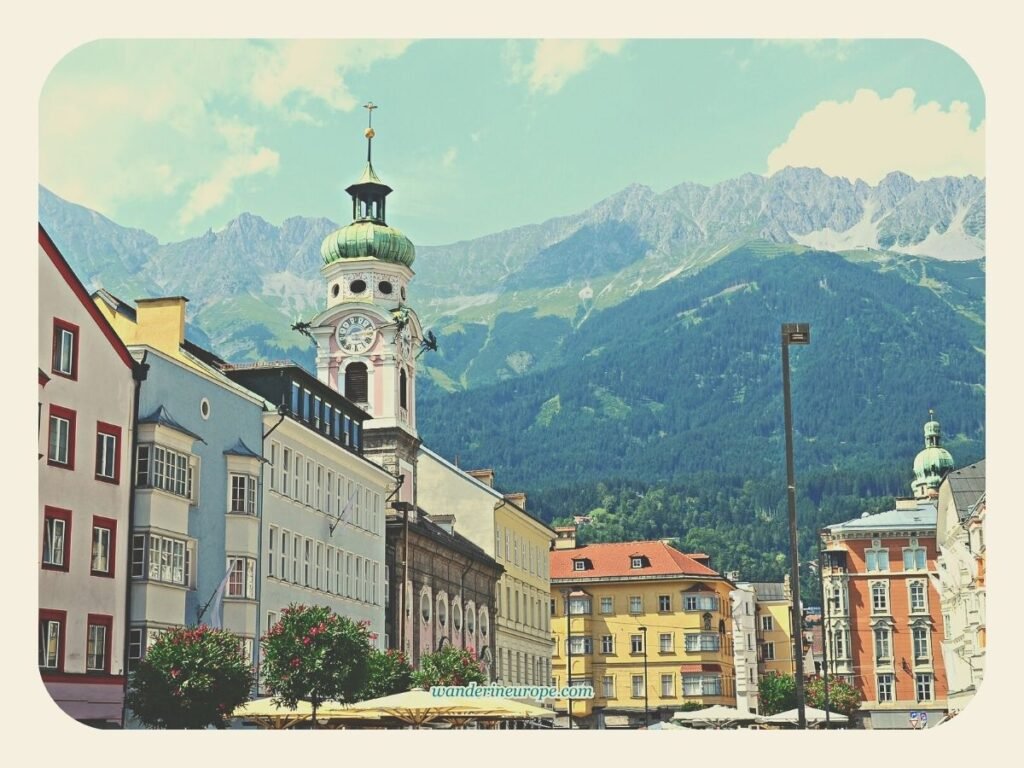
Just a few steps from Triumphpforte, you’ll come across the first of the splendid buildings that line Maria-Theresien-Straße. Keep an eye out for the first batch of these architectural gems as you reach the junction of Meraner Straße and Maria-Theresien-Straße.
Before reaching the junction, you’ll be able to admire the grandeur of several monumental baroque-style buildings, including the Altes Landhaus (No. 43) dating back to 1725, Palais Troyer-Spaur (No. 39) constructed in 1680, and Palais Fugger-Taxis (No. 45).
Among these impressive structures, to me, Palais Troyer-Spaur stands out, particularly due to its captivating and intricate colorful facade. Also, make sure not to overlook Palais Trapp (No. 38), located opposite Altes Landhaus. Take a moment to appreciate the remarkable details beneath the palace’s balcony. The windows are adorned with exquisite stuccos depicting intricately crafted floral motifs, with the Virgin Mary taking center stage.
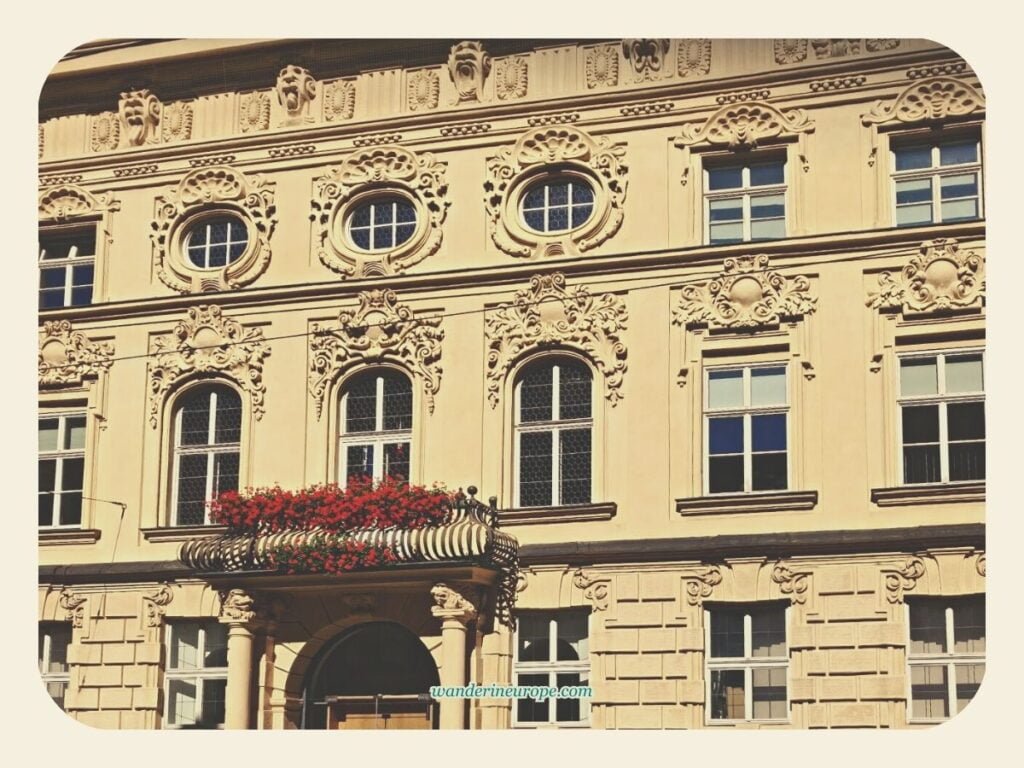
After the junction with Anichstraße, you’ll encounter a series of stunning buildings along Maria-Theresien-Straße. Among them, two noteworthy structures are the mixed Renaissance and Haussmannian style corner building (No. 24) and the building with a captivating mural-painted facade (No. 22) adjacent to it. Also, on the same side of Maria-Theresien-Straße, be sure to spot Gasthaus Alt Insprugg (No. 16), a distinctive building featuring elements of Gothic architecture.
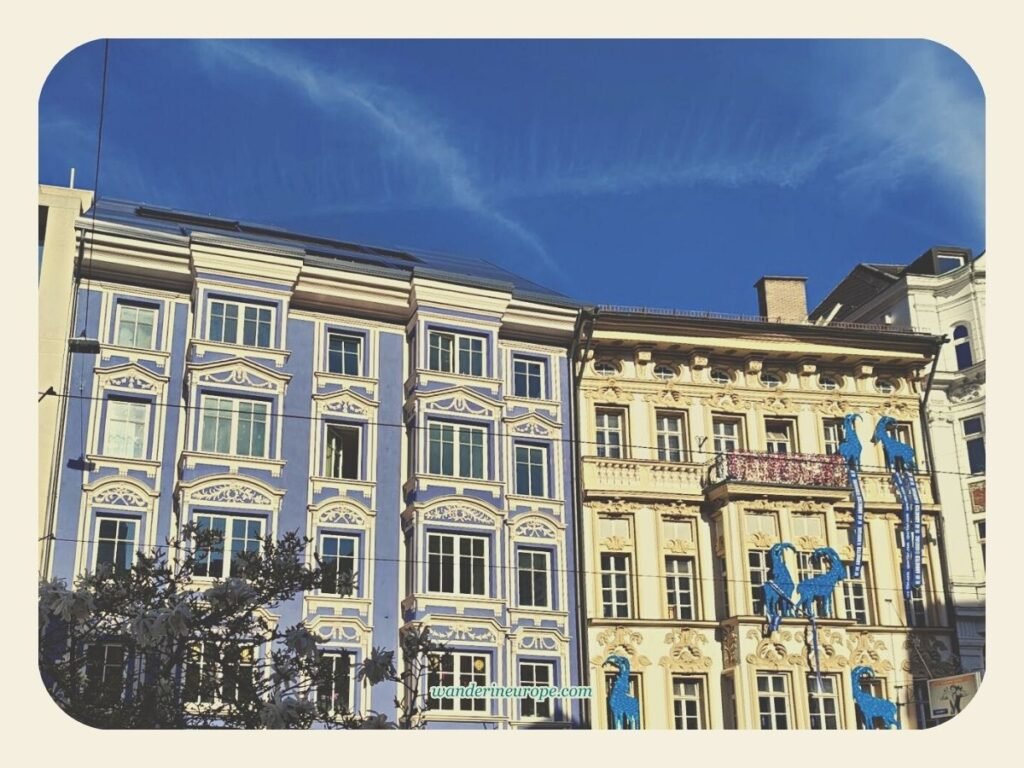
Last but not least, just a few steps further, you’ll come across Spitalkirche, another magnificent building along Maria-Theresien-Straße. This structure is known for its stucco-decorated windows, which are a true visual delight while wandering in Maria-Theresien-Straße. Step inside Spitalkirche to be enthralled by the elaborate interiors adorned with intricate stucco decorations, showcasing the rich craftsmanship of the time.
Destination 3. Golden Roof
While strolling along Maria-Theresien-Straße, you may find yourself immersed in a vibrant atmosphere that can be both exciting and bustling, particularly during the peak season. As you admire the stunning buildings, you’ll also be amidst a lively crowd of fellow wanderers exploring the square, not to mention the magnificent Nordkette mountains that provide a breathtaking backdrop, peeking over the buildings and adding to the scenic beauty of the surroundings.
You’ll also catch whiffs of enticing aromas emanating from the numerous cafes and restaurants that line the square, tempting you with their delectable culinary offerings. The sensory experiences in this vibrant location are sure to leave a lasting impression.
This beautiful impression of Old Town Innsbruck gets even better when you reach Herzog-Friedrich-Straße, the street past the northern end of Maria-Theresien-Straße. It is where you can find the Golden Roof, which is the highlight of visiting Innsbruck’s historic center. It serves as the symbol of Innsbruck itself. And as its name suggests, the Golden Roof is a sight to behold, and you can already guess the reason behind its name.


The Golden Roof’s historical significance and majestic presence leave no doubt as to why it holds the status of Innsbruck’s iconic landmark. This late Gothic oriel, with a loggia, boasts an impressive display of 2,657 fire-gilded copper tiles, beautifully adorning its roof. Take a moment to appreciate the intricate murals and reliefs that grace the entire facade as they depict the captivating story of Maximilian I, one of Austria’s most important historical figures. Truly, they’re a feast to the eyes.
There’s more to see in the Golden Roof than its facade, though; it has a museum inside! Here’s my guide to get an idea about the design, history, and exhibits inside the Golden Roof.
Destination 4. Hölbling Haus
While the Golden Roof takes the spotlight as the most iconic attraction in Innsbruck, it’s not the only one that catches the attention of every visitor who ventures to the very heart of the historic center in Herzog-Friedrich-Straße. If you’re facing the Golden Roof, just cast your gaze to the left, and you’ll be captivated by yet another stunning building. It is called Höbling Haus, sometimes spelled as Helblinghaus.


Details + intriguing fact about Höbling Haus
Featuring an ornate Rococo facade adorned with intricate nature motifs, cherubs, and masks, the Höbling Haus undeniably lives up to its reputation as the most beautiful building in Innsbruck. Like the Golden Roof, my eyes were also treated to its captivating beauty.
Beyond its breathtaking physical appearance, what adds intrigue to the Höbling Haus is the ironic details behind it. Following Sebastian Helbling’s operation of a café in the 19th century, the building transformed into the Catholic Casino in the early 20th century.
Wait, what? Catholic and a casino?
Like many others, I was also initially puzzled by its name. But, in actuality, it didn’t function as a gambling venue but as a meeting place for the Catholic Casino movement in Innsbruck. The movement itself had its roots in southern Germany and emerged as a conservative response to the liberal initiatives aimed at curbing the influence of the Catholic Church, specifically in the realm of education and schools.
In Innsbruck, the Catholic Casino played a vital role as a meeting spot for the city’s conservative residents.
Destination 5. Stadtturm
The historic center of Old Town Innsbruck has much more to offer beyond its stunning landmarks, such as the Golden Roof and Höbling Haus. Amazingly, it can also transport you back in time with the presence of Stadtturm, also known as Innsbruck’s City Tower. It is another landmark in Innsbruck that has stood as a guardian of the city since the mid-15th century.
Here’s everything you need to know about visiting Stadtturm.


Details + What can you expect in Stadtturm?
Standing at a towering height of 51 meters, Stadtturm dominates the skyline when viewed from Herzog-Friedrich-Straße. The city guards stationed in the tower would definitely have had a clear vantage point to spot any potential enemies approaching the city centuries ago.
While Stadtturm traces its origins back to the medieval ages, its current appearance indicates that its last significant modification occurred during the Renaissance. The unmistakable evidence lies in the octagonal upper section of the tower, which is adorned with an onion-shaped dome.
During your visit, it is highly likely that you will see many people in the middle section of the tower. This is because Stadtturm stands as one of the most exceptional vantage points in Old Town Innsbruck, providing breathtaking views of the surrounding area.
Climbing to the top of Stadtturm offers not only a breathtaking experience but it will also allow you to imagine yourself as one of the medieval guards who vigilantly protected the city and warned of impending dangers.
And yes, if you want to see a panoramic view of the Alps without leaving the city, Stadtturm is the place to be. From the viewing deck of Stadtturm, you can also enjoy a clear and panoramic view of Nordkette. It is the mountain range that serves as Innsbruck’s nearest natural attraction and is home to Hefelekar, which offers the highest viewpoint overlooking Innsbruck.
Destination 6. Hofkirche Innsbruck
Among the sights that can immediately catch your eye as you sweep across Innsbruck’s scenic cityscape from Stadtturm’s observation deck is Hofkirche (Court Church), situated to the east of the tower. It is distinguished by its black roof and onion-shaped lone spire when you face east. I refer to Hofkirche as Innsbruck’s ‘don’t-judge-the-book-by-its-cover’ due to its unassuming exteriors and the treasures inside. Here’s everything you need to know about Hofkirche.


Summary of what you can expect in Hofkirche + How to go there
Hofkirche is the must-see after visiting the Golden Roof. This way, you will have a seamless discovery of the rich history of Innsbruck, where influential figures like Maximilian I of the Habsburg dynasty have left an indelible mark. Personally, Hofkirche stands out as one of the highlights of a trip to Innsbruck, and without a doubt, you’ll be captivated by the unique treasures that await you inside.
So, what is Hofkirche all about? Hofkirche, also known as the Innsbruck Court Church, is a remarkable place built by Emperor Ferdinand I as a tribute to his esteemed grandfather, Maximilian I.
Within the walls of this church, you’ll encounter some of the most treasured artifacts in Innsbruck, including the breathtaking cenotaph of Emperor Maximilian I and the exquisitely crafted sculptures known as the “Black Men” in the German Renaissance style.
If you’re in search of awe-inspiring artworks during your time in Innsbruck, your quest will be fulfilled the moment you lay eyes on Emperor Maximilian I’s cenotaph and the remarkable Black Men statues. These masterpieces are truly the most captivating works I’ve had the pleasure of discovering in Innsbruck.
In addition to its extraordinary treasures, Hofkirche is an absolute must-see in Innsbruck due to its architecture.From the intricately adorned vaulted ceiling adorned with stunning stuccos to the meticulously crafted wrought iron railings that gracefully divide the different sections of the church, every aspect left me marveling, and I’m sure it will have the same effect on you.
Good to know: Hofkirche is also home to the tomb of Andreas Hofer, a remarkable figure who started as a Tyrolean innkeeper and went on to become a revered leader during the Tyrolean Rebellion against Napoleon’s army and the Bavarian Invasion. Today, he is celebrated as the national hero of Tyrol.
Want to go to Hofkirche? It’s a mere three-minute walk along Hofgasse from Herzog-Friedrich-Straße, where the Golden Roof is situated, to reach Hofkirche. The entrance to Hofkirche can be accessed through the Tyrolean Folk Art Museum, which conveniently adjoins Hofkirche along Universitätsstraße.
Destination 7. Hofburg Innsbruck
As you make your way from the Golden Roof to Hofkirche, you’ll undoubtedly notice the magnificent Hofburg. This grand, white, and elegant building will catch your eye as you emerge from Hofgasse and continue walking along Universitätsstraße towards Hofkirche. Hofburg, also known as the Imperial Palace, holds a place of utmost importance in Innsbruck, much like the Golden Roof and Hofkirche. Here’s everything you need to know about Hofburg.


Summary: Hofburg + what to expect
It is no surprise that Hofburg is also widely recognized as a significant landmark not just in Innsbruck but across all of Austria. Because throughout history, it has served as the residence for numerous royals who reigned over the Holy Roman Empire for extended periods. Renowned figures such as Emperor Maximilian I, Empress Maria Theresa, Duke Leopold IV, and many other prominent names have called Hofburg their home.
While Hofburg Innsbruck may not possess the same grandeur on its exterior as the Imperial Palace in Vienna, it would be a mistake for visitors to overlook this remarkable landmark. If you have an appreciation for marvelous architectural masterpieces, Hofburg has a wealth of treasures to offer.
With its long and storied history, stretching for seven centuries, the palace has undergone numerous renovations and repairs commissioned by the empresses and emperors who once resided there. As a result, Hofburg has become a captivating blend of architectural styles. Exploring the halls and imperial apartments, you’ll be treated to not just two or three architectural styles but an impressive array of five: Italian, Gothic, Renaissance, Baroque, and Rococo.
A visit to Hofburg offers more than just admiring the grand and opulent rooms, though. You’ll also discover a modern exhibition dedicated to Maximilian I, which beautifully complements your historical learning journey from the Golden Roof to Hofkirche.
Destination 8. Innsbruck Cathedral
Let’s say you have just finished visiting the Golden Roof, Hofkirche, or Hofburg. The next place of interest to visit, Innsbruck Cathedral, is only a few steps away. Innsbruck Cathedral is an absolute must-see due to its status as one of the most significant Baroque structures in Tyrol. Its interiors, created by the famous brother artists from Munich, made my jaw drop. Discover all the beautiful things inside Innsbruck Cathedral here.


Summary: Interesting details about Innsbruck Cathedral + discover Innsbruck’s religious gem!
At first glance, the facade may not reveal its true grandeur, but the moment you step inside, you’ll be captivated by its undeniable beauty.
If you’re already familiar with the renowned Asam Brothers from Bavaria and their incredible contribution to the interiors of Innsbruck Cathedral, you’ll not doubt the sheer beauty of this magnificent place even if you haven’t seen it yet. The artistic genius of the Asam Brothers radiates throughout every inch of the church, making Innsbruck Cathedral a true masterpiece.
Did you know that the Asam Brothers actually have their very own church right in the heart of Munich? Although it may be small in size, this enchanting sanctuary holds a special place in the hearts of locals and visitors alike. In fact, it’s widely regarded as one of the most awe-inspiring gems in the vibrant city of Munich.
Going back to Innsbruck Cathedral… As you step inside the church, your eyes will be drawn to its remarkable ceiling. One cannot help but marvel at the extraordinary cycle of frescoes adorning the ceiling, vividly portraying the life of Saint James, the church’s patron saint. These breathtaking frescoes were skillfully painted by none other than Cosmas Damian Asam, who employed mesmerizing optical illusions, creating a sense of endless space that captivates the imagination.
But that’s not all! The stucco works within Innsbruck Cathedral were expertly crafted by Egid Quirin Asam, the talented younger brother of Cosmas Damian. Through his meticulous attention to detail and the vibrant form and colors he employed, Egid Quirin bestowed upon the cathedral an impressive touch of Renaissance visual vocabulary. What’s even more remarkable is how harmoniously the stucco works and frescoes created by the Asam brothers complement each other, especially evident in their thoughtful color selection.
The result is a visually stunning masterpiece that leaves a lasting impression on all who enter.
While it’s true that the breathtaking frescoes and intricate stucco works adorning the domes of Innsbruck Cathedral will likely captivate your gaze, it would be a mistake to overlook the remarkable marvel beneath your feet. Make sure to take a moment to appreciate the mesmerizing marble floor, which boasts an imaginative display of intricate geometric patterns. In fact, this remarkable floor is renowned as one of the finest examples of its kind throughout all of Austria.
For those who hold deep religious faith, visiting Innsbruck Cathedral offers an extraordinary opportunity to witness the revered painting of Maria Hilf (Mary of Succor) by Lucas Cranach the Elder, dating back to 1530.
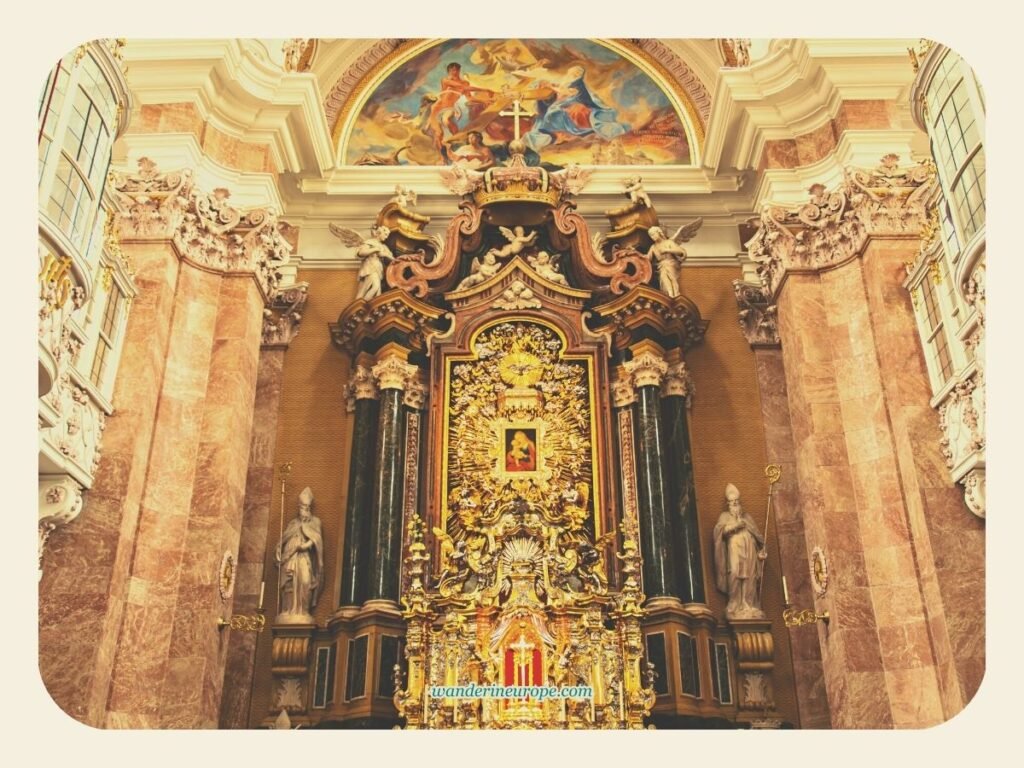
This iconic masterpiece holds a significant place among the most venerated Marian images in all of Christendom. You’ll find it prominently displayed above the main altar, serving as a powerful symbol of devotion and inspiration.
Destination 9. Herzog-Friedrich-Straße Landmarks
Exploring Old Town Innsbruck wouldn’t be complete without experiencing the most iconic view of the city. Head over to Innbruck, the bridge that spans the River Inn, where you’ll be treated to a picturesque sight of the city’s colorful houses against the backdrop of majestic mountains.
If you’re already in Old Town Innsbruck and near the cherished landmarks we just discussed, reaching this bridge is a breeze. While there are several routes to choose from, I highly recommend taking a leisurely stroll along Herzog-Friedrich-Straße for a more enjoyable experience in Innsbruck. By the way, if you haven’t heard about it yet, Herzog-Friedrich-Straße is also home to other notable attractions like the Golden Roof and the Höbling Haus.

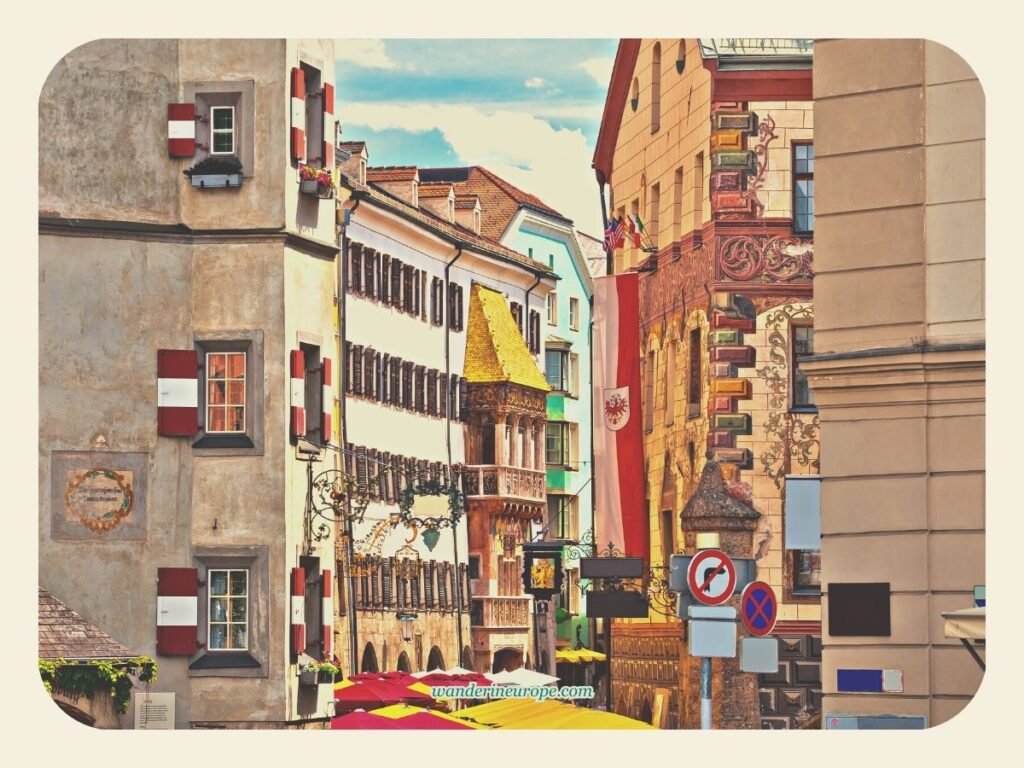

As you continue down this street, you’ll also come across three more magnificent buildings: Gasthof Goldener Adler, Ottoburg, and Altes Regierungsgebäude. They’re the three beautiful buildings you’ll see before you emerge to Herzog-Otto-Straße, the road parallel to the River Inn.
Discover: Altes Regierungsgebäude
On your way along Herzog-Friedrich-Straße towards the Innbruck bridge, I’m positive that you’ll like the Baroque building you’ll see on your right, known as the Altes Regierungsgebäude.
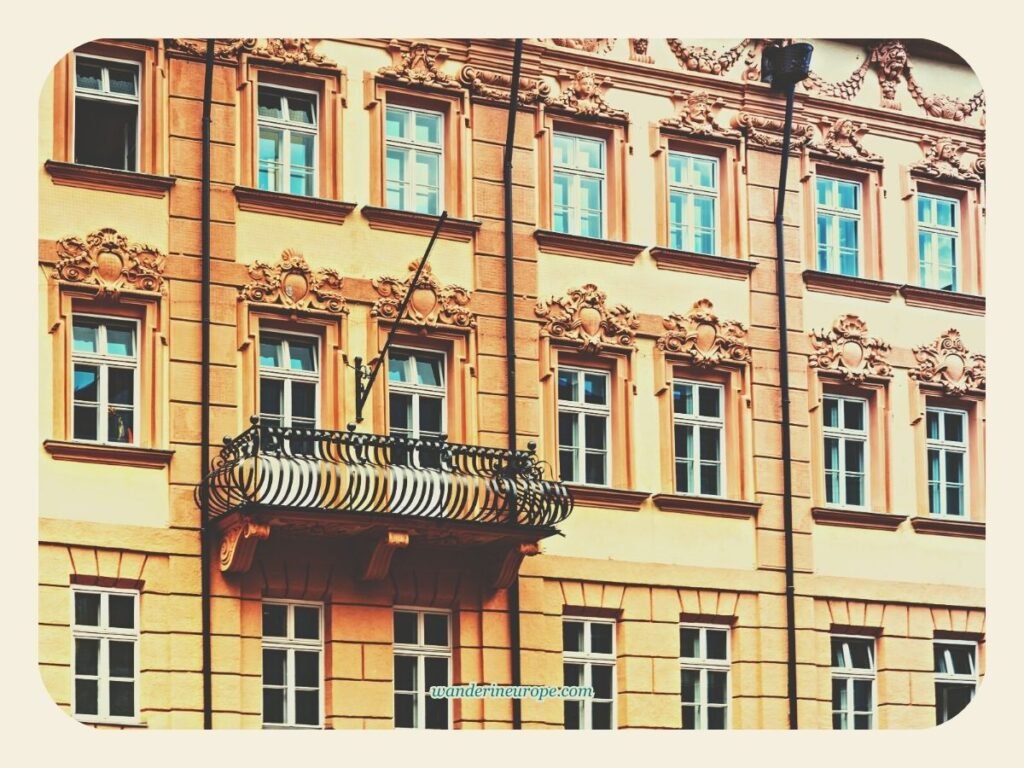
Its elegance is remarkable, with exquisitely detailed reliefs adorning the entire frontage. Even from a distance, it catches the eye and leaves a beautiful impression.
Originally named Zerrenmantelhaus, this architectural gem became the old government building in 1569 when Archduke Ferdinand II acquired it. For many years, it served as a vital hub for political, judicial, and administrative services in Tyrol.
Initially a Gothic structure like many other beautiful houses in Innsbruck, the building underwent a redesign after the 1689 earthquake that struck the city. While its facade was altered, traces of the Gothic style can still be seen within its rooms, adding to its unique character.
Across from Altes Regierungsgebäude stands another captivating building in Innsbruck, brimming with character and adorned with eye-catching murals on its facade.
Discover: Gasthof Goldener Adler — MUST SEE!!
This remarkable establishment is known as Gasthof Goldener Adler or the Golden Eagle, and it has held its place as one of the most beloved historical inns in Innsbruck for many years.
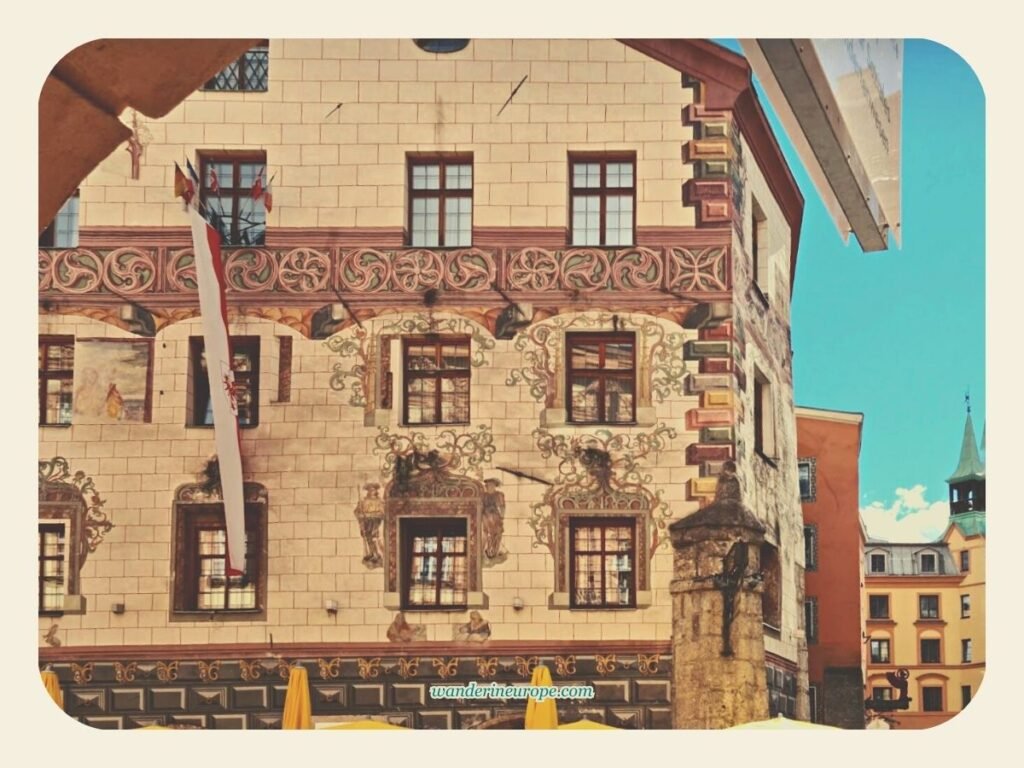
Here’s an interesting tidbit: did you know that Andreas Hofer, the Tyrolean freedom fighter, once addressed the people of Innsbruck from the balcony of the Golden Eagle after capturing the city?
If you’re curious, keep an eye out for a plaque near the entrance of the inn tucked under the arches. It serves as a testament to the momentous speech delivered by Andreas Hofer in 1809.
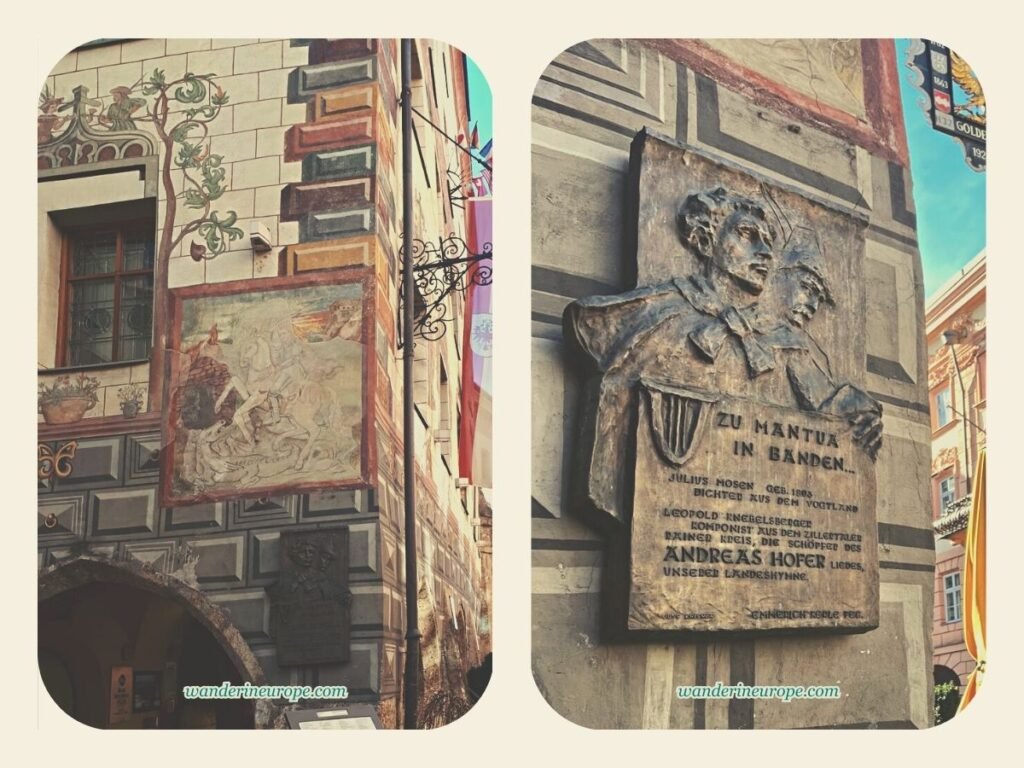
As Innsbruck acts as a gateway between Germany and Italy, it’s no surprise that not only common folk but also kings, nobles, and artists have graced the halls of Gasthof Goldener Adler. In fact, even the esteemed Johann Wolfgang von Goethe, renowned for his significant contributions to German literature, had the pleasure of staying at this illustrious inn.
Discover: Ottoburg
As you continue your leisurely stroll along Herzog-Friedrich-Straße, just before reaching the Inn River, you’ll come across a rather intriguing building known as Ottoburg. This distinctive structure catches the eye with its windows adorned in the colors of the Austrian flag.
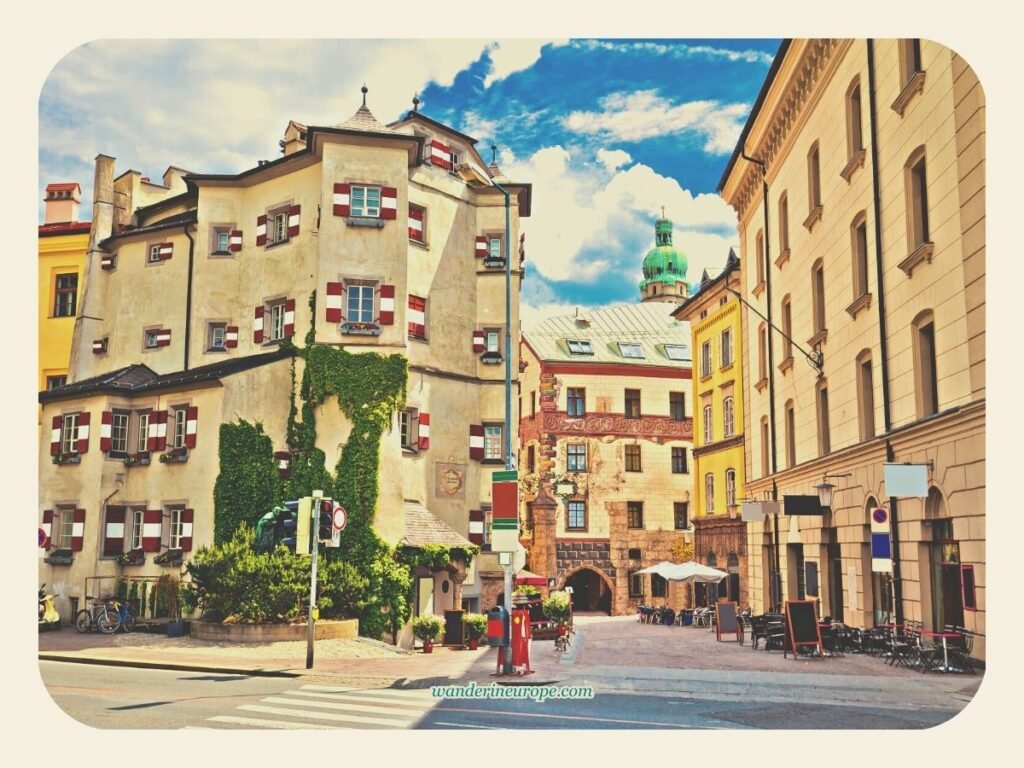
Dating back to medieval times, Ottoburg originally served as one of Innsbruck’s fortifications at the Inn Gate. Intriguingly, after it was converted into a residential building and privately owned in the late 15th century, it remained unoccupied for an extended period.
It was the time when locals began referring to it as the “öd burg,” which translates to “empty castle.” Over time, this name transformed into what we know today—Ottoburg. Since 1913, Ottoburg has been serving as a delightful restaurant, offering an array of mouthwatering Tyrolean specialties. You might want to step inside and treat yourself to some delicious Tyrolean cuisine before you finally see the most iconic view of Old Town Innsbruck with its colorful houses!
Destination 10. Innbrück and the Colorful Houses
After meandering through the enchanting streets of Old Town Innsbruck and immersing yourself in its rich heritage, there’s no grander finale than reaching the spot that offers the most iconic view of Innsbruck.
In that spot, you can have the moment when you can truly say that you have experienced the essence of Innsbruck, as the view encompasses the River Inn, the towering mountains, and the picturesque, colorful cityscape. It’s the perfect opportunity to capture unforgettable photos and delightful selfies, serving as enduring mementos of your journey to Innsbruck.

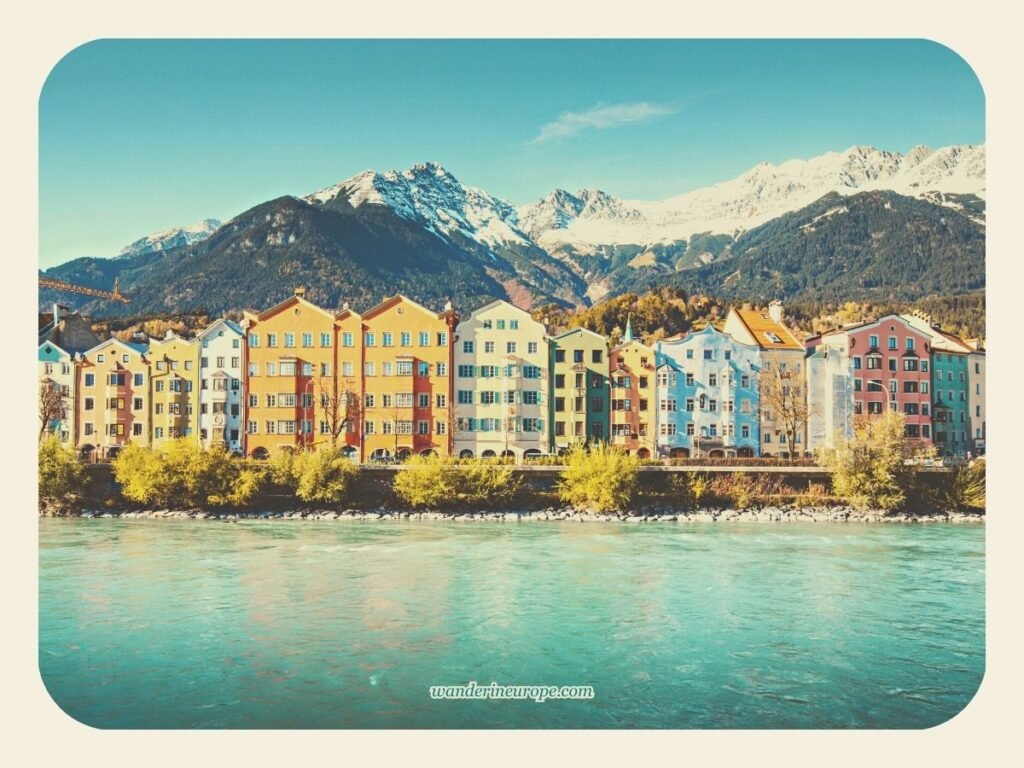

So, where can you find this breathtaking view? Look no further than the Innbruck Bridge itself—the very bridge that spans across the River Inn. Once you reach this vantage point, you’ll be treated to a sight that epitomizes the beauty of Innsbruck, leaving you with lasting memories of this remarkable city.
Resources
That’s a wrap on my self-guided walking tour of Old Town Innsbruck! If you’re looking for more Innsbruck inspiration, feel free to check out my Innsbruck archive or this dedicated site about Old Town Innsbruck. That’s where I gathered the facts for this walking tour. Enjoy your adventure in this amazing city!
Hey there! Planning a trip to Innsbruck but still looking for a place to stay? Check out my partner’s hotel search and booking platform. I’m a big fan of their great hotel deals and speedy map feature. Just a heads up, the link is an affiliate one. This means I might earn a small commission if you book a hotel through it. No extra fee at you. Think of it as a way to support WanderInEurope. Your support helps me create more helpful content like this free self-guided walking tour. Thanks for your support!

Suppose you’ve soaked up all that Old Town Innsbruck and its surrounding attractions have to offer, and you’re itching to explore more of Austria. In that case, Salzburg should be next on your list. Like Innsbruck, it’s nestled in the Alps, but it offers a unique charm with attractions that are straight from a movie set, like the Mirabell Palace and Garden. While a day in Salzburg is a treat, a 2-day stay lets you truly experience the city. And if time allows, dedicate three days to Salzburg! From there, you can take day trips to other stunning Alpine destinations like Hallstatt, Berchtesgaden, and St. Gilgen. Don’t miss out!
Links open in a new tab.


